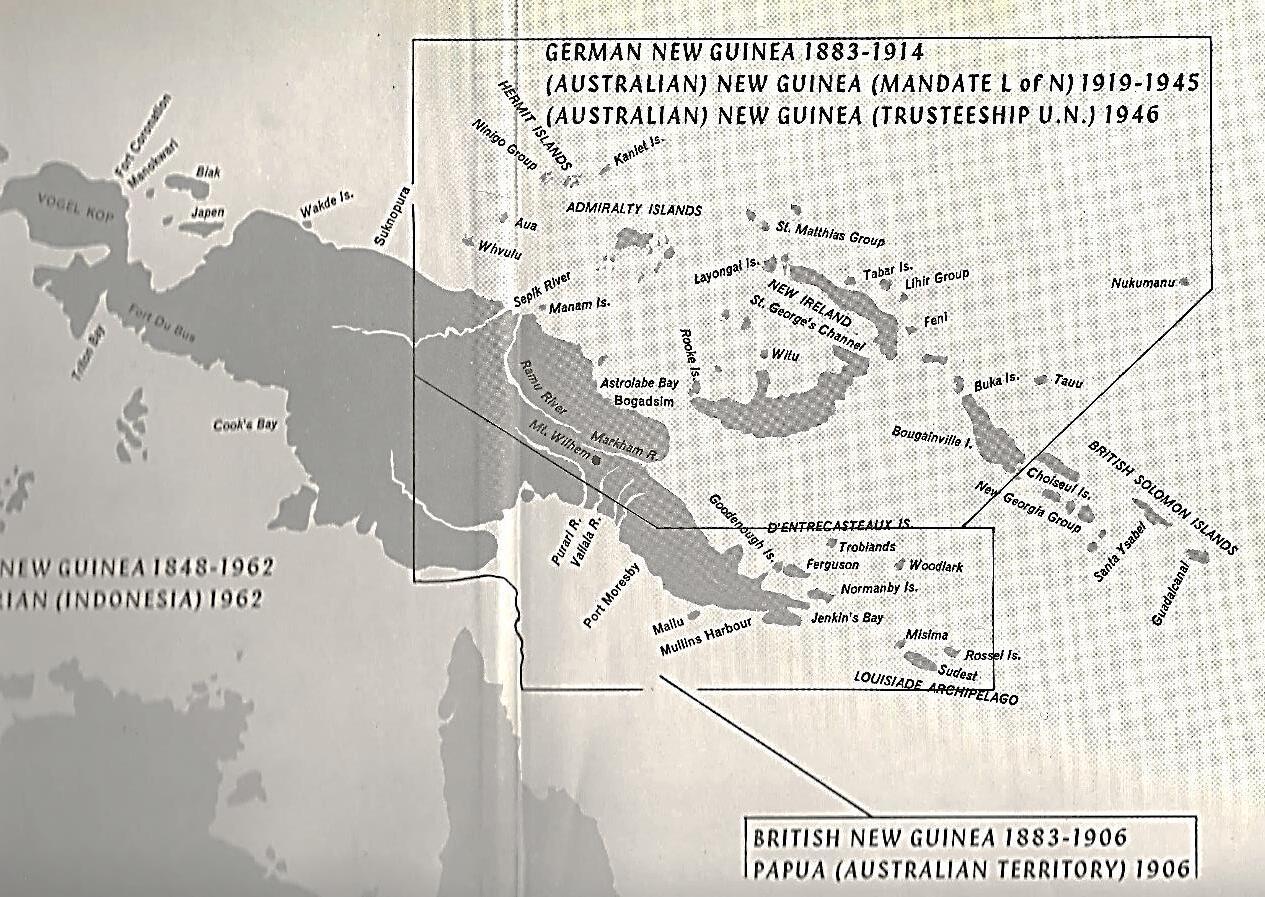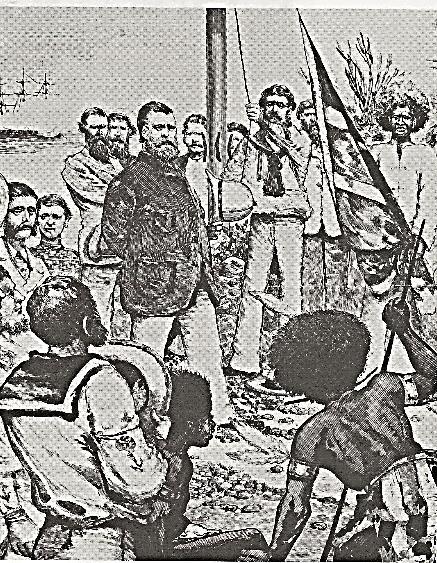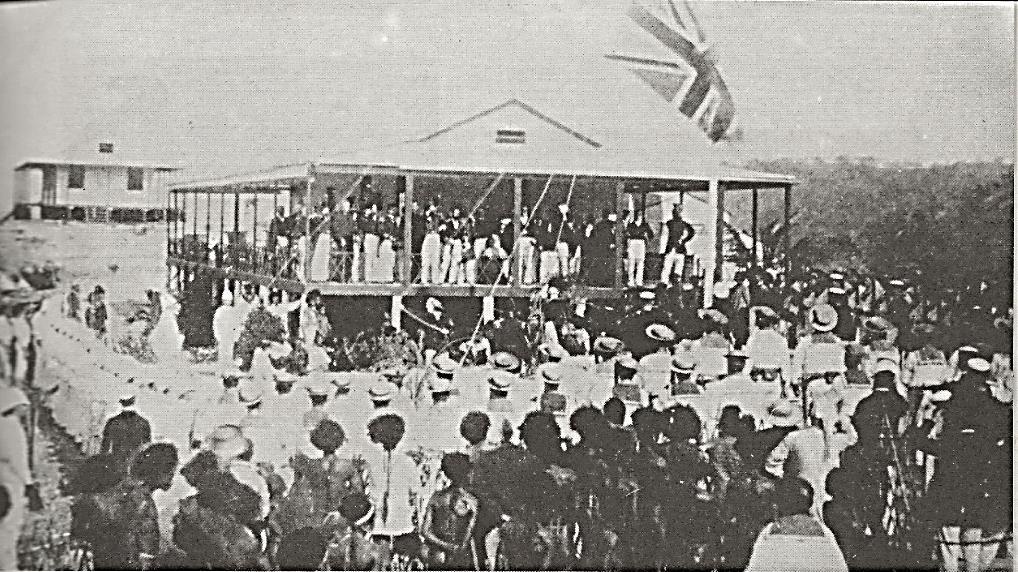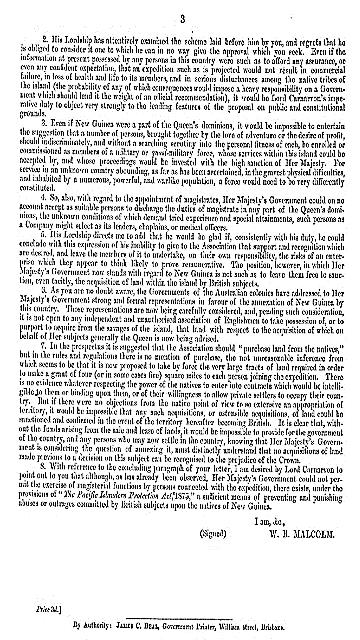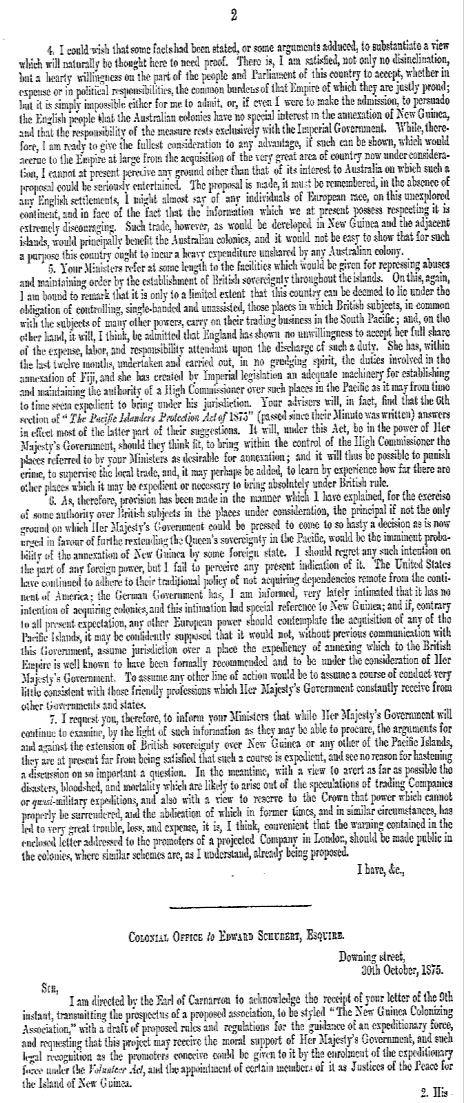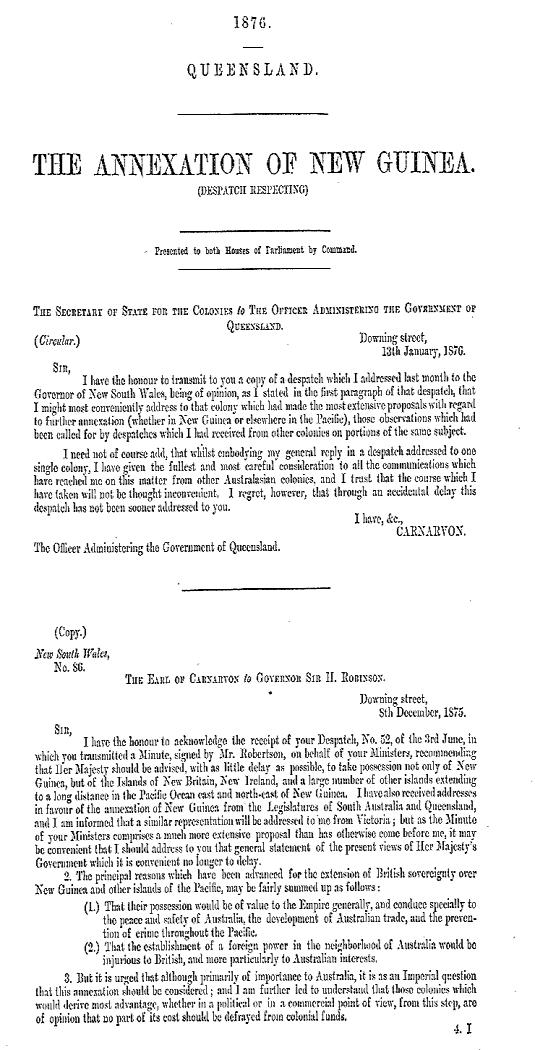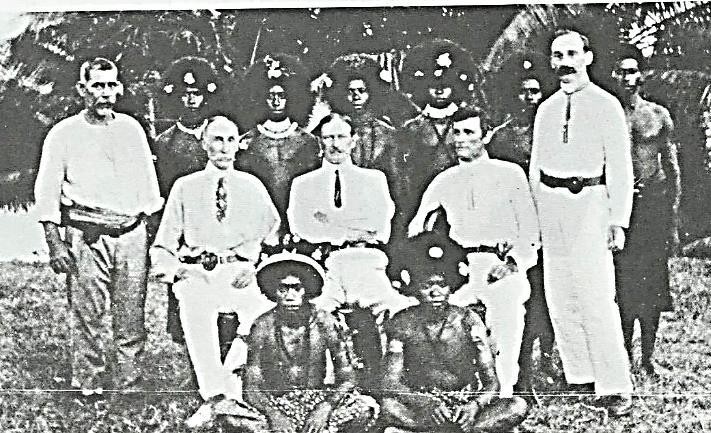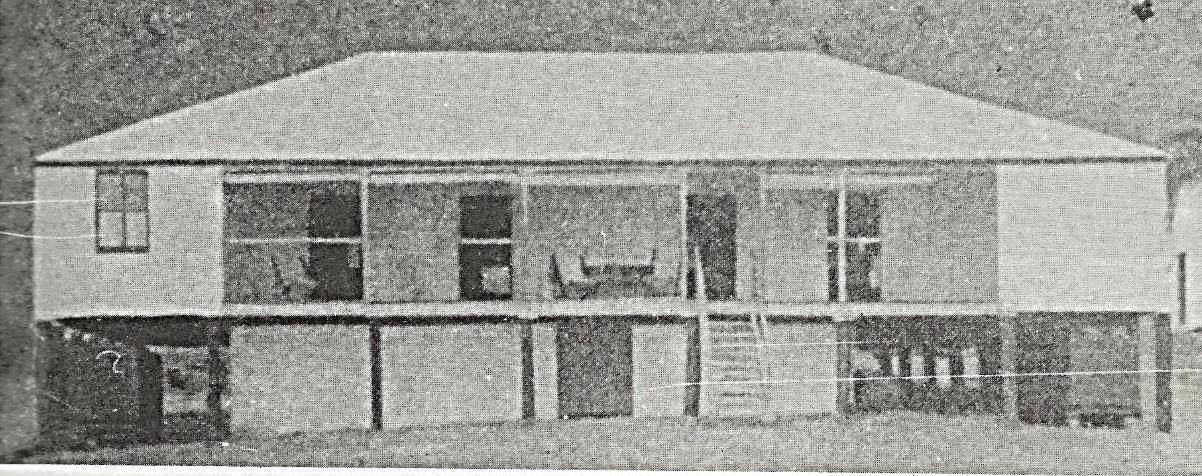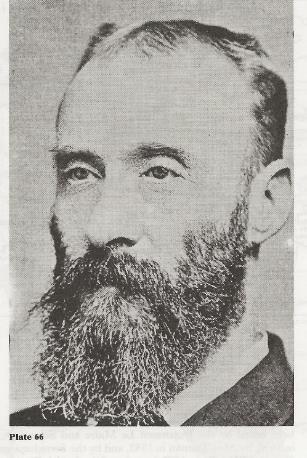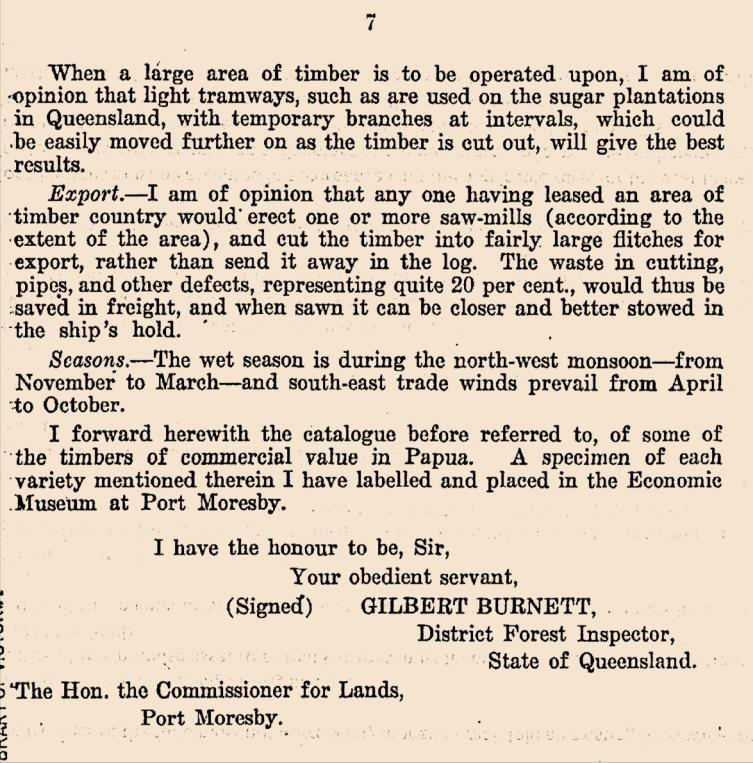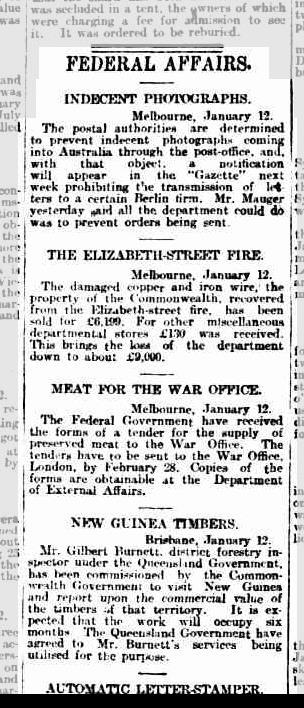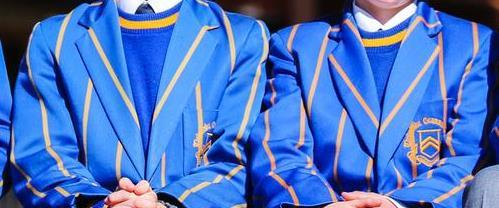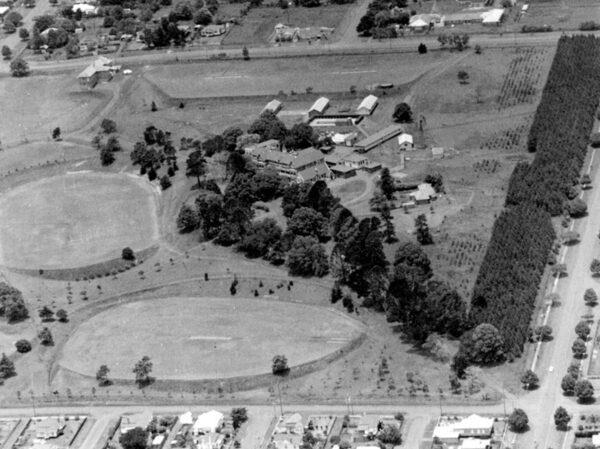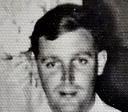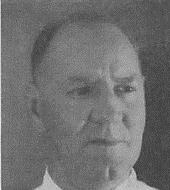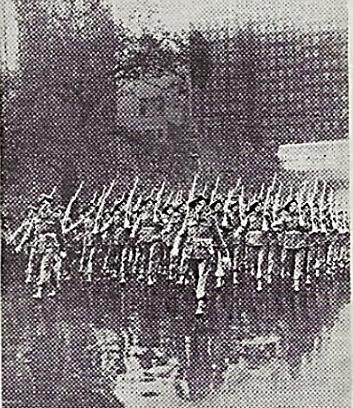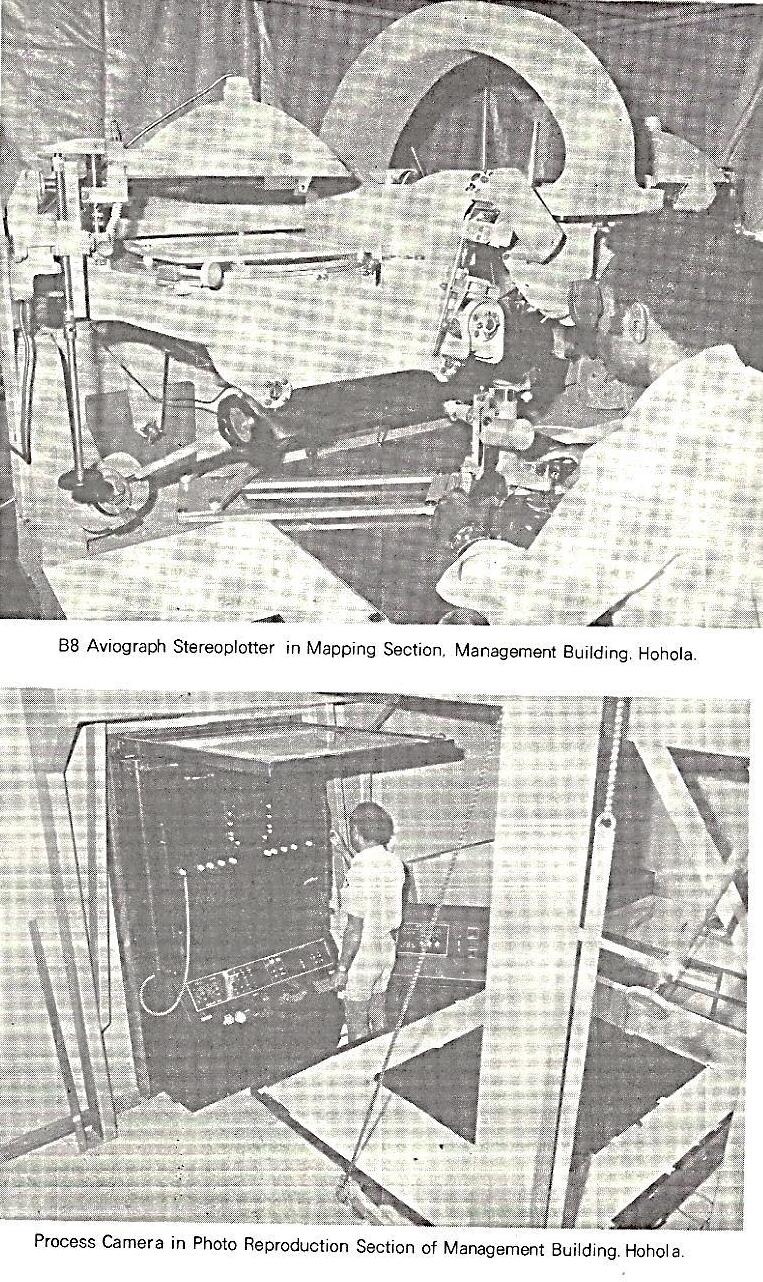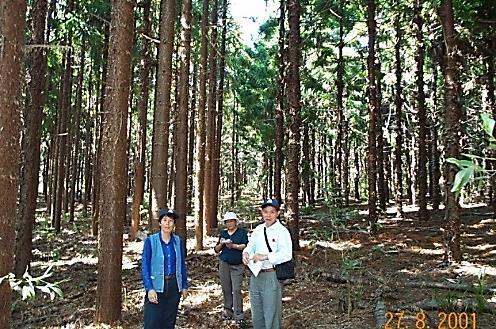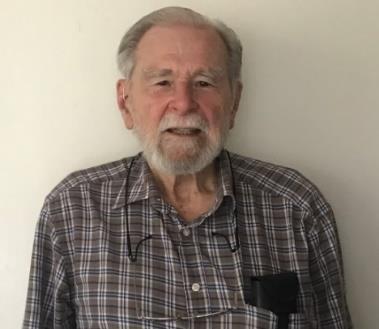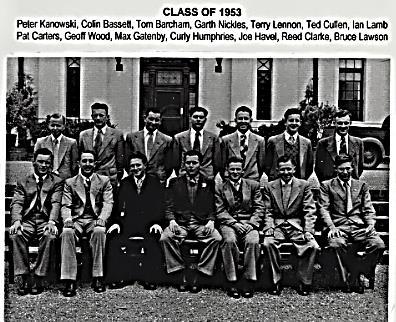AUSTRALIAN FORESTERS in PAPUA NEW GUINEA 1922-1975
PNGAF MAGAZINE ISSUE # 9Q2 of 25th April 2023. QUENSLAND/ PNG FORESTER MIGRATIONS
Migrations of foresters between Queensland and PNG by land, sea, and air have greatly assisted the business of PNG Forestry in building a better PNG.
Queensland Foresters, an increasingly strategic resource for today and tomorrow in terms of sustainable management of wood fibre
Queensland = kwin graun


Home town = asples bilong mi
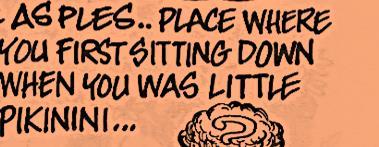
1
Editor R B McCarthy1 2023
1 Dick McCarthy District Forester TPNG Forests 1963-1975.
B’LONG MI
GRAUN
AS PLES
KWIN
TABLE OF CONTENTS


“FORWOOD” page 3
TIMELINE page 4 Specific Timeline Incidents page 4
MIGRATION BETWEEN QUEENSLAND AND PNG page 7
Causes for Human Migration between Queensland and PNG page 7
Lust for Gold page 7
IMPACT OF MIGRATION ON PNG’S FOREST DEVELOPMENT page 11
MODES OF MIGRATION TRANSPORT page 13
By Water page 13
By Foot page 17
By Air Transport page 20
By Cloud page 25
By Road Vehicle Transport page 26
EARLY QUEENSLAND/PNG ACTIVITIES page 30
Attempt to annex British New Guinea 1883 page 30
New Guinea Exploration Expedition 1885 page 33 Material Migration 1886 page 33
Queensland Family Forester Influence 1906 page 33
Gilbert Burnett Timber Investigation 1908 page 34
Human Mind Technology Transfer page 37
Australian Forest Survey Group 1943/1945 page 38
Mapping Cooperation page 39
Tree Breeding Cooperation page 40
FORESTERS AS PLES QUEENSLAND page 41
ACRONYMS page 61
2
“FORWOOD”
Forester migration linkages between Queensland and PNG greatly assisted political, economic and security development in terms of PNG forestry.
There is a long standing and enormous wood trade between Australia, (especially Queensland) and PNG encompassed within a sphere of similar forest types and forest products bound by many existing long-term areas of mutual co-operation within the respective government and private sectors.
As in Australia, the discovery of gold in PNG, had great implications not only on its forests, but on the migration of Queenslanders in their lust for gold. Coupled with the impact of two world wars and unemployment, a collation of Queensland forestry mercenaries, misfits and missionary citizens became enmeshed in PNG life and PNG activities.
During the early colonial period, there were two separate pieces of legislation in place to control the exploitation of the forest resources in the two territories: the Timber Ordinance, 1909 Papua, and the Timber Ordinance, 1922 of the Territory of New Guinea. Many of the participants in the developing PNG forest industry came from Queensland.
By the 1930s, this increasing pressure on the easily accessible forest for sawmilling purposes led to the passing of the Forestry Ordinance, 1936-37 for regulation of the forest sector (Mantu2, 1985). Eminent3 TPNG forester Jim Belford4 highlighted that this was done by the Australian Administration referring to the Queensland Forest Act of that time.
The ensuing regulations for application in the then Territory of Papua and New Guinea, included the transfer of forest rights through Timber Rights Purchases, (rights to forest resources were acquired by the Administration). This allowed the TPNG administration to regulate commercial forest production activity, while outright land ownership rights remained with the traditional owners.
It is interesting to note that of the AFS intake in 1946 of 15 forester cadets, the 6 Queensland cadets all had served in PNG. Four cadets (Carron, Ralston, Robinson and Volck together with ranger Carter) were with McAdam’s forest survey group. Separately, Gardner was in the RAAF in PNG and Hanson (who later to became Head of the Commonwealth Forest and Timber Bureau Canberra) was in the RAN in the south-west Pacific.
Yet again Queenslanders to the rescue
2 Mantu, J. 1985. The history of forest development in Papua New Guinea. In: Vigus, T.R. [ed.]. Seminar proceedings. The future of forestry in Papua New Guinea, held at the PNG University of Technology, Lae, 18th – 19th November 1985.
3 PNGAF Mag Issue #9D2 of 15/10/2021
– The Development of PNG’s forest Management Systems.
4 PNGAF Mag Issue #9B-5B4B1 OF 12/7/21 - Eminent TPNG Forester Jim Belford.
3
TIMELINE 5
Early European Explorers
PNG Investigations by European Explorers
German New Guinea
Neu Guinea Compagnie 1884-1899
German New Guinea 1899 to 1914
Australian Military Administration 1914-1921
The Mandated Territory 1921-1942
British New Guinea (now Papua)
British New Guinea 1884-1906
Papua 1884-1906
Papua 1906 -1942
Papua and New Guinea
World War 2 and ANGAU 1942-1947/8
SPECIFIC TIMELINE INCIDENTS
1883 Chester attempts annexation of British New Guinea (now Papua) for Queensland.
1885 New Guinea Exploration Expedition (1885) on behalf of the three eastern states of Australia (Victoria, New South Wales, Queensland).
1905 Papua Act 1905.
1908 Gilbert Burnett Timber Investigation Papua.
1918-1924 New Guinea Forestry Timber Resources Papua – Investigation.
1920/21 Commonwealth New Guinea Expedition.
1920’s Major gold find along the Bulolo River prompts another gold rush.
1922 Timber Ordinance New Guinea.
1922 C.E. Lane Poole commenced assessment of forests of Papua then NG.
1925 Lane Poole published report on forest resources of Papua & New Guinea.
1935 Lane Poole, C.E., 1935. ‘Report on the Forests of the Goldfields of New Guinea: Together with Recommendations Regarding a Forest Policy for the Whole Territory.’
1936 Timber Ordinance of New Guinea superseded by the Forestry Ordinance 1936.
1938 Jim McAdam accepted a permanent position in the Mandated Territory of New Guinea as a Forestry Officer for establishment of a Forest Service.
1939 Jim McAdam made Chief Forestry Officer of New Guinea.
1939 Jim Cavanaugh to PNG with Jim McAdam.
1940 Jim McAdam, Jim Cavanaugh, Reay Weidenhofer signed up with NGVR. (New Guinea Volunteer Rifles) on 19th September 1940.
1940 Ted Collis enlists at Casino.
1940 Eric Dobson enlisted at Wollongong.
4
5 PNGAF MAG # 2 of 7th Oct 2020 European Impact on PNG until 1975 as pertaining to the PNG Forest Sector.
1940 Robert Cattanach enlists at Rockhampton.
1940 Lindsay Smith joined the Australian Army at Annerley Qld.
1940 Alan Fraser enlisted at Maryborough.
1940 Keith Cullen enlists Manly Qld.
1940 Darby (Douglas Henry) Munro joined at Ayr.
1940 Don Fryar enlists at Rose Park.
1940 Alan Gardner enlists RAAF.
1940 Bert Hanson enlists in RAN.
1940 Frank Holland enlists PNGVR.
1940 Darby Munro enlists at Kelvin Grove Queensland.
1941 Bill Suttie enlists at Brisbane.
1941 George Barrcroft enlists at Toowong as a sapper.
1941 Bert Gloynes enlists at Toowoomba.
1941 Dick Reilly enlists at Matraville.
1941 Michael Jackson enlists in Brisbane with RAAF.
1941 Kevin White enlists at Bulwa.
1941 Ernie Clifton enlists at Bexley.
1941 James Nugent enlists with Army in North Sydney.
1942 J K McCarthy and Frank Holland (a timber getter) rescue some 200 Australian soldiers after the fall of Rabaul.
1942 Frank Vickery enlists at Wau.
1942 Ken Fraser enlists at Adelaide.
1942 Adam Mulholland enlists 1 Bomb Disposal Coy Forest Survey Coy.
1943 Larry Edwards enlisted at Darley.
1943 Alec Richardson Queensland forester enlisted in RAN.
1943 John Lowien enlists at Paddington.
1943 Col Pittaway joins 9 Battalion VDC.
1943 Conference in July for formation of 1 CRE (New Guinea Forests).
1944 During WW 2, Forestry matters including cutting and milling of timber controlled by the Army through the 1 CRE (New Guinea Forests.) OIC J B McAdam MM.
1944 Les Carron joined the Australian Forestry survey group PNG.
1944 Cyril Tenison White Queensland Government Botanist worked with the Australian Forestry survey group PNG.
1944 Ed Volk Qld Forestry joined Australian Forestry survey group PNG.
1944 Jack Ralston Qld Forestry to Australian Forestry survey group PNG.
1944 Tony Robinson Qld Forestry- Australian Forestry survey group PNG.
1944 George Carter Qld Forestry Australian Forestry survey group PNG.
1945 1 CRE (New Guinea forests) units were gradually phased out towards the end of 1945 after the war had ended.
1945 Following the surrender of the Japanese in 1945, civil administration of Papua as well as New Guinea was restored. Under the Papua New Guinea Provisional Administration Act (1945-46), Papua and New Guinea were combined in an administrative union.
1940’s John Thompson with occupational forces in Japan.
5
1946 First announcement of formal forest policy, army forestry records and equipment taken over by the administration. Former army personnel recruited to form the nucleus of the forest department e.g., Jim McAdam, Jim Cavanaugh, Frank Vickery.
1946 John Thompson served with Occupational Forces Japan.
1947 Appointment of Cadet Foresters for Territory of Papua New Guinea.
1948 Ted Gray TPNG Forestry Cadetship.
1950 Alan Ross joins TPNG Forests.
1952 Robin Morwood TPNG Forestry Cadetship.
1953 Frank Coppock TPNG Forestry Cadetship.
1955 Ian Grundy TPNG Forestry Cadetship.
1955 Des Harries TPNG Forestry Cadetship.
1955 Gerry Vickers TPNG Forestry Cadetship.
1955 Dave Dunn joins TPNG Forests.
1956 Alan Cameron TPNG Forestry Cadetship.
1957 Eric Hammermaster TPNG Forestry Cadetship.
1957 Kevin White joins TPNG Forests.
1958 Evan Shield TPNG Forestry Cadetship.
1958 Rex Wiggins joins TPNG Forests.
1960 Ted Roach, Ken Skyring, Les Austin, Artur Mobbs of Kerevat sawmill reassigned to new roles within TPNG Forests.
1960 Neil Brightwell TPNG Forestry Cadetship.
1960 Phil Ainsworth joins TPNG Forests.
1962 Paul Ryan TPNG Forestry Cadetship.
1963 Ken Granger joins TPNG Forests.
1963 Greg McDonald joins TPNG Forests.
1965 Neville Howcroft joins TPNG Forests.
1966 Barry Gray joins TPNG Forests.
1967 Ross Wylie joins TPNG Forests.
1967 Mike Jones joins TPNG Forests.
1968 Brendon Bailey joins TPNG Forests.
1969 Brenton Peters joins TPNG Forests.
1970 Jim Belford joins TPNG Forests.
1971 Bob Thistlethwaite joins TPNG Forests.
6
IMPACT OF MIGRATION9 on PNG’S FOREST DEVELOPMENT TILL 1975
The Sunda and Sahul landmasses as about 50,000 to 60,000 years ago when people first came to Sahul10 .
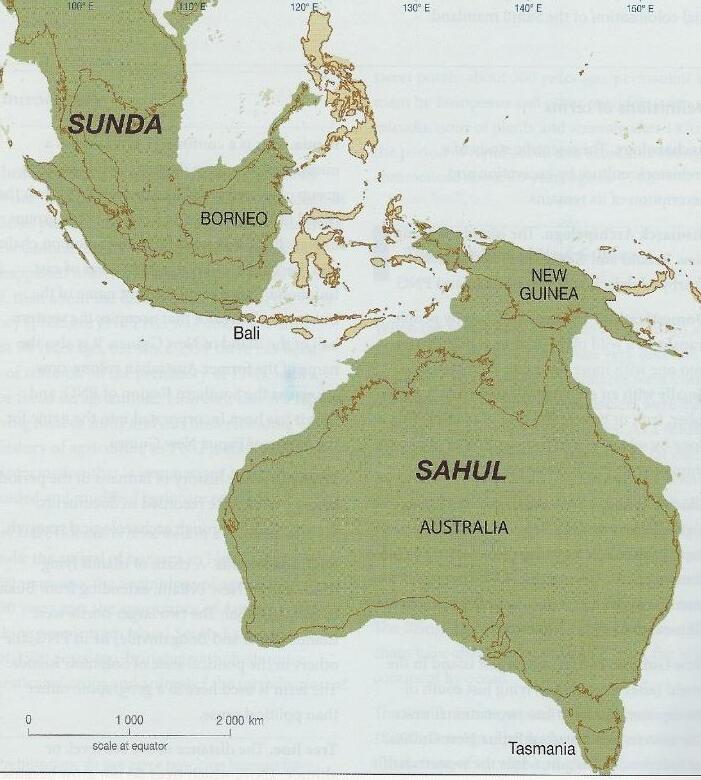
The first intervention into PNG’s Forest sector was early Man who was a hunter and food gather. Archaeological evidence indicates that humans arrived on New Guinea perhaps 60,000 years ago. Although the first arrivals were hunters and gatherers, early evidence shows that people managed the forest environment to provide food and indications of Neolithic gardening having been practiced at Kuk. They could have come from the south of what is now Queensland as well as north, from what is now known as Asia.
The second intervention into PNG’s forested lands occurred some 5-10,000 years ago when new arrivals brought with them the knowledge of gardening and the plants to cultivate, most of which had their origin in the rainforests of Southeast Asia. They brought basic elements for a subsistence economy: plants like taro, yam, banana, and coconut as well as three domesticated animals – the pig, dog, and chicken. A few native plants suited to cultivation they found in PNG as sago palm, sugar cane, certain types of bananas and breadfruit. For thousands of years, these people as the sole inhabitants of PNG, the forests of PNG made a vital contribution to their lives and livelihood. To the hunter, the forests meant birds and animals for food and personal adornment. In the forest clearings people made gardens. From the forest wood, people shaped their garden implements, carved their spears, bows and arrows, their clubs and other weapons for hunting and war. The forests gave them fuel, bark, and fibre for clothing. It provided timber for shelter and thatching for roofs. The forests gave them their sole means of transport, i.e., the canoe log. The people whose technologies included bone, wood, and stone tools, had a productive agricultural system. They traded along the coast (mainly in pottery, shell ornaments and foodstuffs) and in the interior (exchanging forest products for shells and other sea products). They came from Asia and maybe from Queensland.
The third intervention11 came in the 19th century with the arrival of the European. Initially the newcomers had little impact on PNG’s forested land or the role the forests
9 P14-17 PNG Mag Issue #1 of 1 oct 2020.
10 Bourke RM and Harwood T Food and Agriculture in Papua New Guinea. ANU Press 2009
11 PNG Mag Issue # 2 of 7th Oct 2020.
11
played in the customary life of the people. Lewis12 provides a detailed analysis of land settlement by Europeans and the early vicissitudes of plantation agriculture in British New Guinea and Papua up until the outbreak of war in the Pacific in 1942. They came from Europe and Queensland.
The fourth intervention13 came in the 20th century with World War 2. The demands and devastation caused by the war, the expanded services needed to cater for the immediate development of the community, plus an increased demand for sawn timber in Australia provided the impetus to expand the scope of the forests from its traditional role. They came from Japan, Europe, Australia and especially Queensland.
The fifth intervention came in the 1960’s with the United Nations Sir Hugh Foot Report14 of 1962 and subsequent World Bank Economic Report15 of 1965 setting out the framework for agricultural and forestry development. This included a major assessment of PNG’s Forest resources and the need for agricultural development for oil palm plantations. This impacted greatly on the forested lands of PNG, especially in New Britain with the advent of clearing large tracts of forested land for the planting of oil palm. The development of this agricultural pursuit also saw PNG enter the global log export trade because the large-scale clearings created an enormous quantity of felled trees, which if not sold were to be burnt. They came from USA to Australia, especially Queensland.
The sixth intervention came in 1968 with the House of Assembly announcing a development program for the PNG forest industry (1968-69 to 1972-73) which greatly impacted on the forested lands of PNG. Much of the existing forest development in PNG today stems from that plan. The major objectives of that plan were to:
o Rapidly increase the production of forest products
o Increase export earnings and local employment by encouraging local processing of forest products.
o Improve the supply and quality of forest products for local use.
o Establish a fully integrated forest industry by the development of industrial complexes working within permanent forest estates.
o Foster a measure of local equity participation in such industrial undertakings.
o Increase the levels of training and employment in the industry.
o Enforce environmental protection standards.
o Adopt logging code of practice. (In 1996, the PNG logging code of practice was formally adopted by the PNG government)
They came from Australia especially Queensland and by now included many who had come in the previous interventions.
12 Lewis DC The PLANTATION DREAM -Developing British New Guinea and Papua 1884-1942
13 PNG Mag issue # 3 of 30th oct 2020.
14 Sir Hugh Foot UN Visiting Mission Report to Trusteeship Council May -June 1962 and refer to page 36.
15 Refer page 37.
12
MODES OF MIGRATION TRANSPORT
In all directions, Queenslanders came and went by water, ground, and air.
BY WATER
Departure HMS Pearl Sydney Harbour 17th Feb 1877. Source16
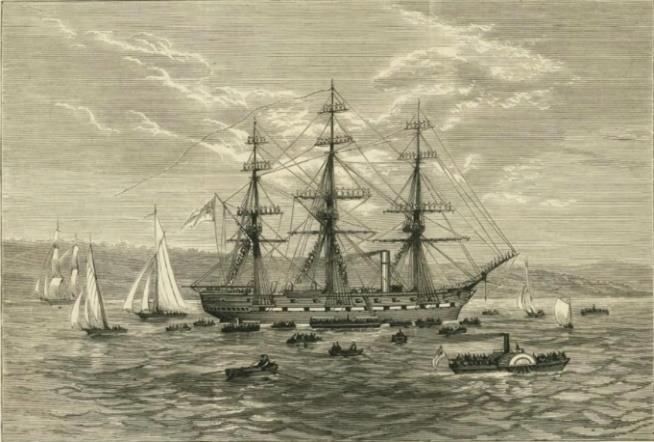
1887 detailing a Lakatoi used for trade between Port Moresby and the Gulf of Papua which was dependent on trade winds.
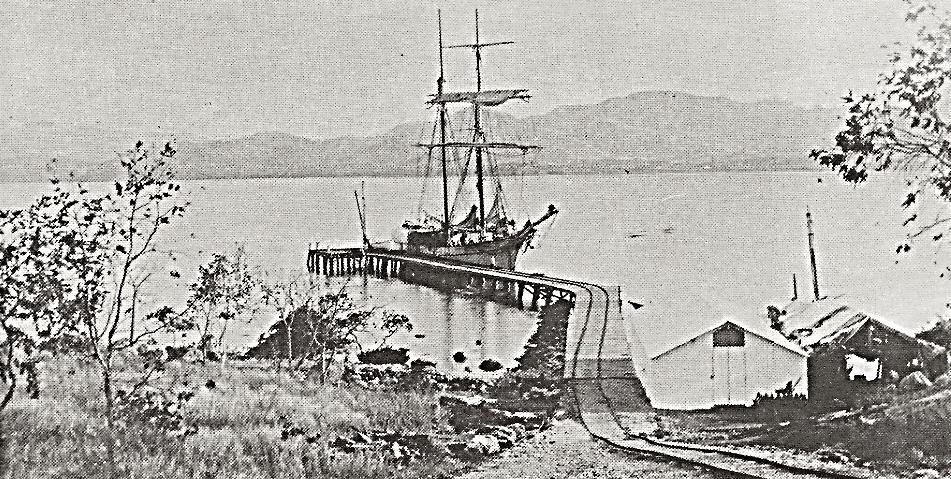
Burns Philp, and Company wharf Port Moresby 1896. Schooner Myrtle on a bi-monthly mail run service Thursday Island to Port Moresby. Source Burns. Philp and Company.
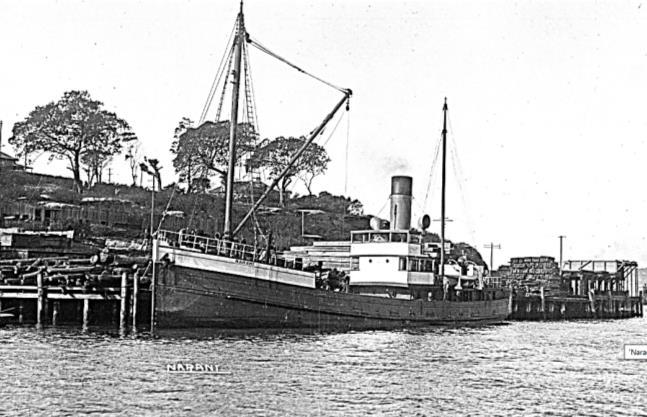

Wooden steamer Narani at Goat Island17 Source Dufty Collection (Courtesy Graeme Andrews). GLMRSNSW (Great Lakes Manning River Shipping NSW).1951
16 Illustrated Sydney News and NSW Agriculturalist and Grazier (NSW 1872-1881) Sat 3 March 1877.
17 PNGAF Mag Issue # 9JW3 of 19th Nov 2022 – Phases of Industrial development p87.
13
John Smith was peeved that he had to go through Wewak wharf customs in 1962. Photo credit Ian Smith -
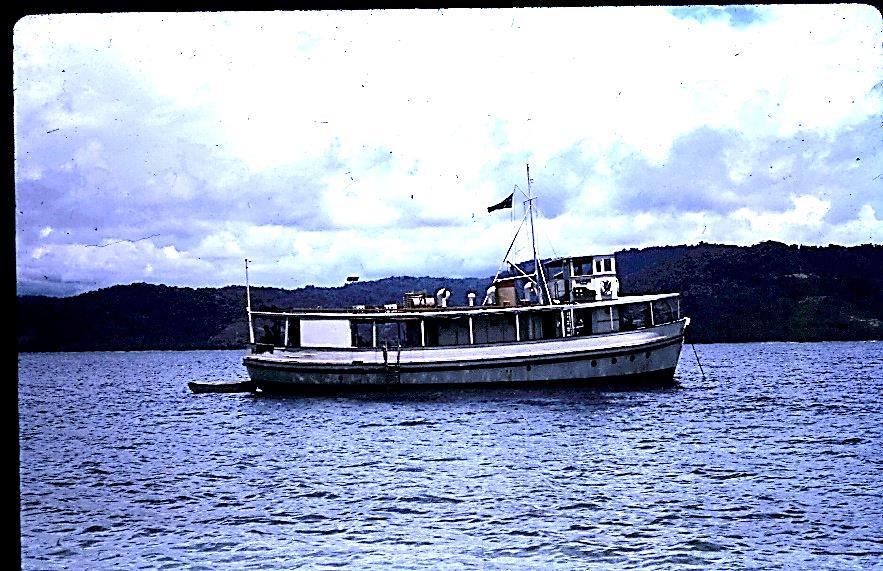
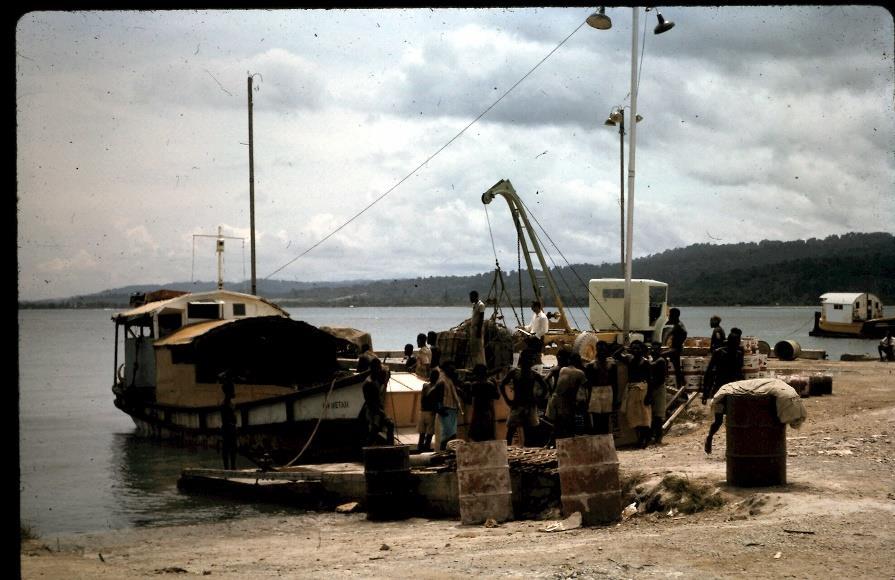
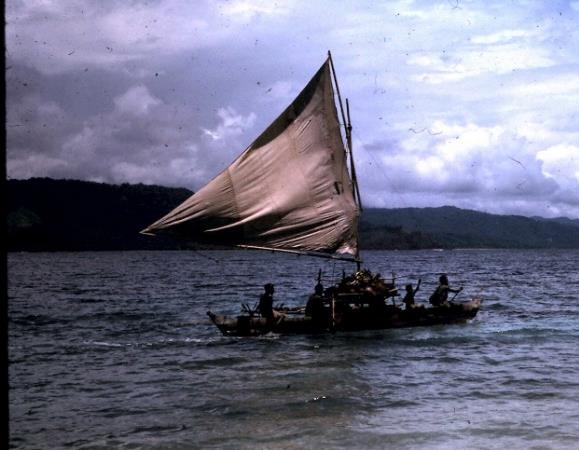
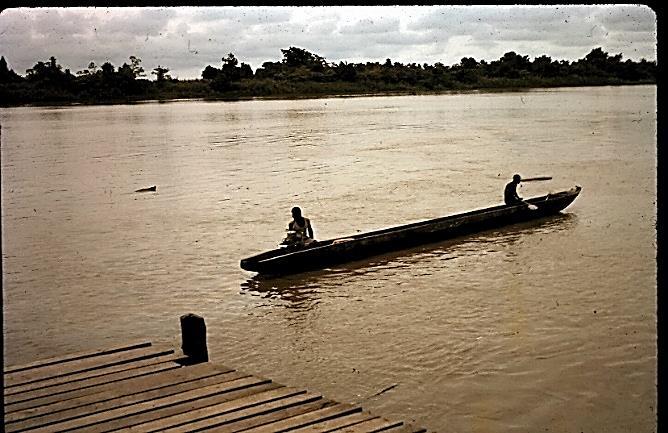
14
John Smith tried by Lakatoi 1960, then by canoe on Sepik River near Angoram to get to PNG. Photo credit Ian Smith. (Father John Smith’s collection).
Father John Smith’s collection.
John Smith tried the MV Rouna Falls - Bill Tebb 1963.
Photo credit Ian SmithFather John Smith’s collection.
Ken Granger trying to get there by water ski at Linga Linga, May 1966.

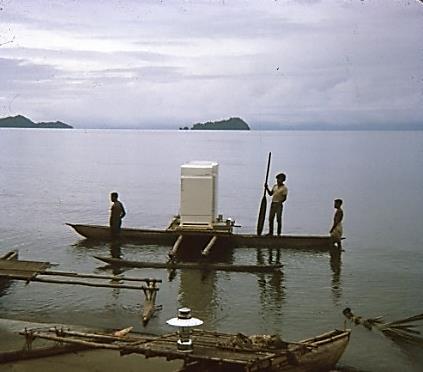

Photo credit Ken Granger
Pual River 1970. Meanwhile Mike Jones was bringing beer supplies.
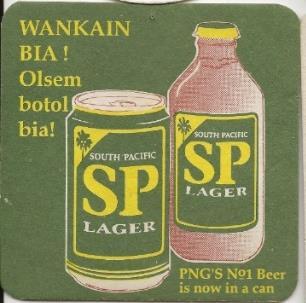
Photo credit Mike Jones.
Ken Granger tried the Boat - The Toa at San Remo, May 1964.
Photo credit Ken Granger.
15
Ian Whyte attempted to come by boat. Open Bay 1974.
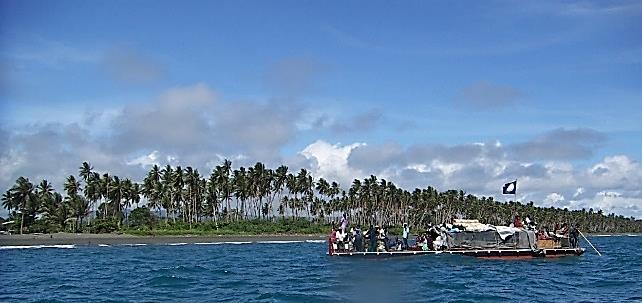
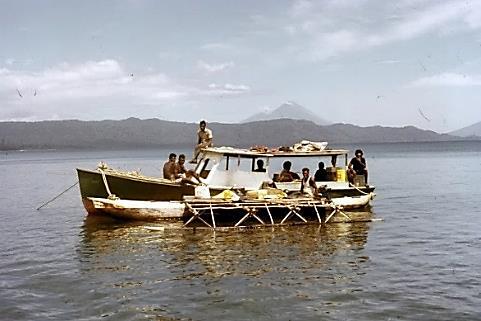
MV Bulolo was launched in 1938. She was a 6,267-ton passenger and cargo ship of the Burns, Philp Shipping Company operating in the South Pacific. Her shipping route was the mail service from Australia to PNG including Solomon Islands, New Hebrides, Norfolk, and Lord Howe Islands.
Still Trying to get there
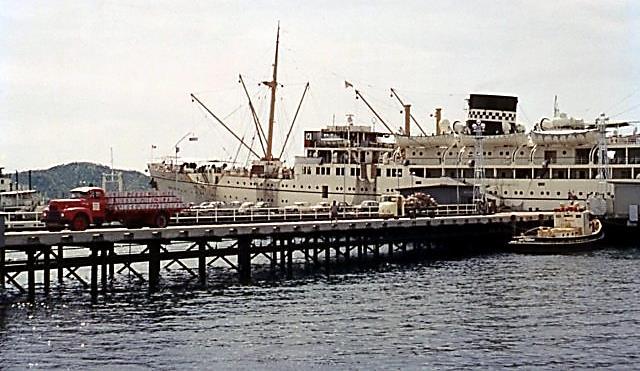
16
Photo credit Ian Whyte
MV Bulolo Port Moresby Harbour 1963. Source Bob Grieve PNGAA.
Large lakatoi off Abau Island.
Photo credit Dick McCarthy 2004.
BY FOOT
An expedition preparing to set out from Port Moresby in 1885 for the crest of the Owen Stanley Ranges. Source 1959 Commonwealth Dept. of Territories.


17
Paul Ryan on patrol.
Photo credit Dept of Forests PNG. 1967.
Gogol Survey 1961 Crossing Gogol River.

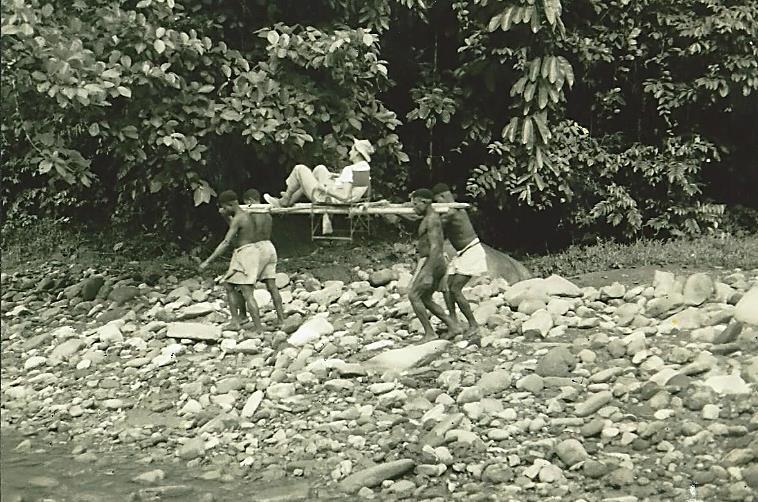
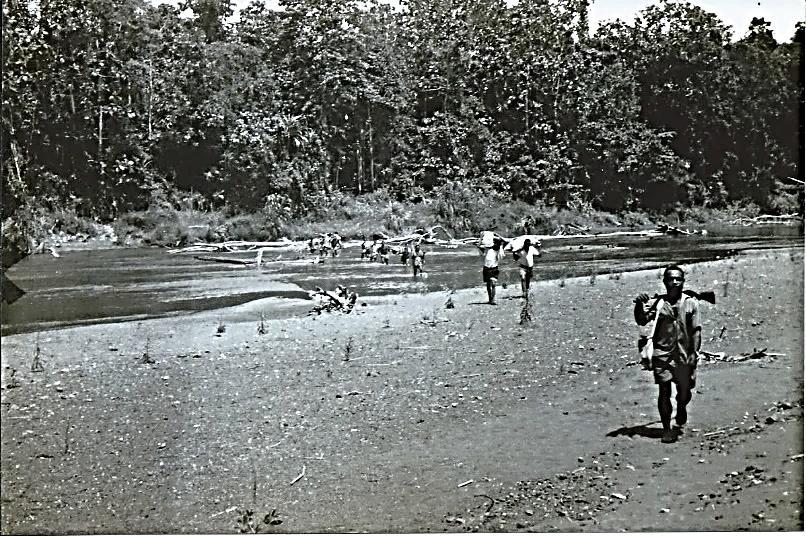

Photo credit Mary Jenkin.
Buggar upAmbulance 1962 Bill Jenkin being carried out due to a poisoned leg.
18
Photo Credit Mary Jenkin.
Dave Lamb Gogol River 1973.
Photo credit Ian Whyte.
Dave Lamb eating on the walk. Photo credit Ian Whyte.
Ian Wythe Sai River 1974. NB. less bagpipes.

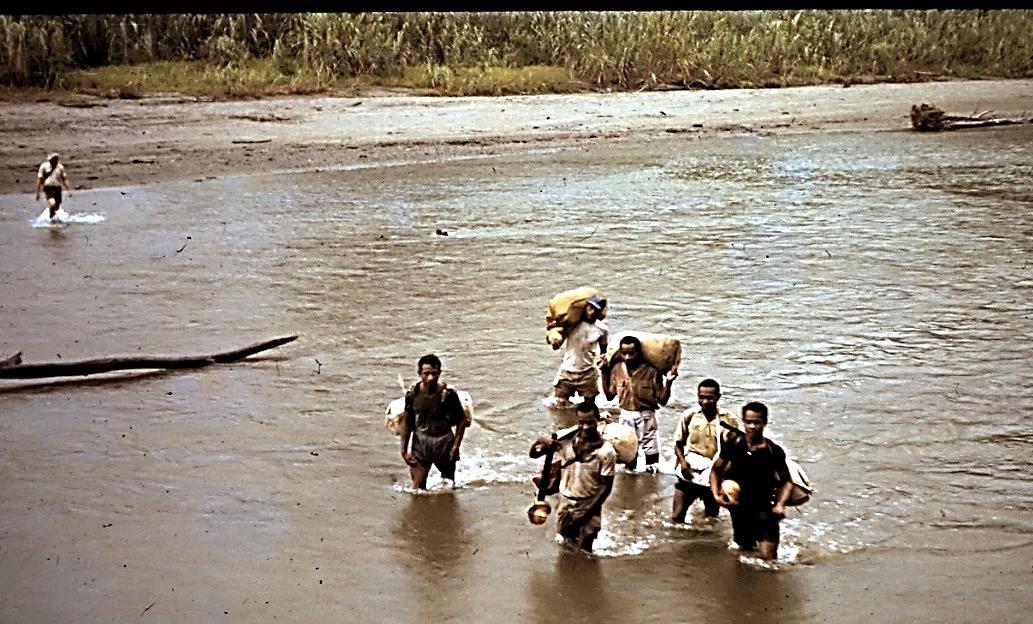
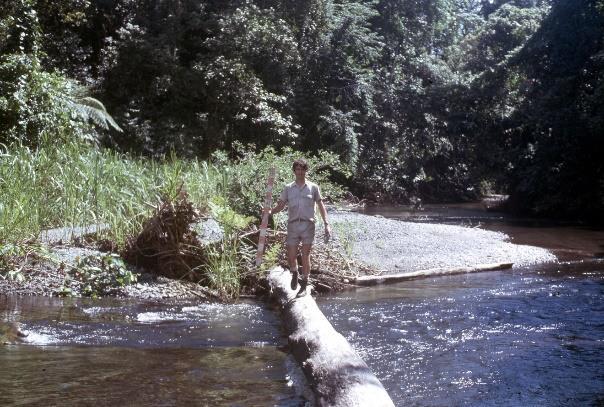
19
Photo credit Ian Whyte.
Alan Cameron enroute crossing Pual River.
Photo credit Ian Smith - Father John Smith’s collection.
Alick and Molly Dockrill in the Kassam Pass Area, Jan 1969.
Photo credit Mark Coode.
BY AIR TRANSPORT
Queensland migration quickened with the stimulation of gold discoveries, airfields for example were opened in the 1920’s at Salamaua, Wau and later Lae. Aircraft used ranged from Super Constellations on the external routes and DC.3’s on major internal routes to small easily maneuverable aircraft on small strips in rugged countryside
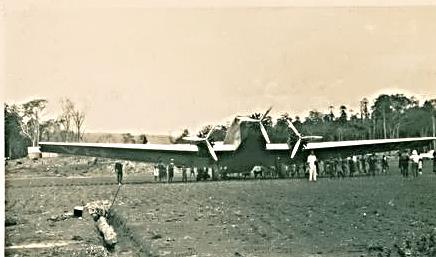
In the 1930s Guinea Airways19 became one of the largest air transport operators in the world, carrying more freight by air than the rest of the world's airlines put together. Among other cargoes, throughout the 1930s eight 3,000-ton gold dredges were flown from Lae, on the New Guinea north coast, to Bulolo and Wau in the Highlands in one of

18 Parer Raymond, John Paul 1984-1967 by Keith Isaacs. Australian Dictionary of Biography Vol 11, 1988.
19 PNGAF Mag Issue # 9JW3 of 19th Nov 2022 – Phases of industrial Development p43.
20
Ray Parer’s18 Bristol plane on Ela Beach Port Moresby. Parer pioneered the aerial service between Port Moresby and Wau. Source. Trove. Pacific Island Monthly Vol 1, No 4 of 20th Nov 1930.
Junkers G31go at Bulolo airstrip (presumably) 1930’s. Source PNGAA.
the first major airlift operations. Since there were no roads, every piece of the dredge had to be designed to be air transportable.
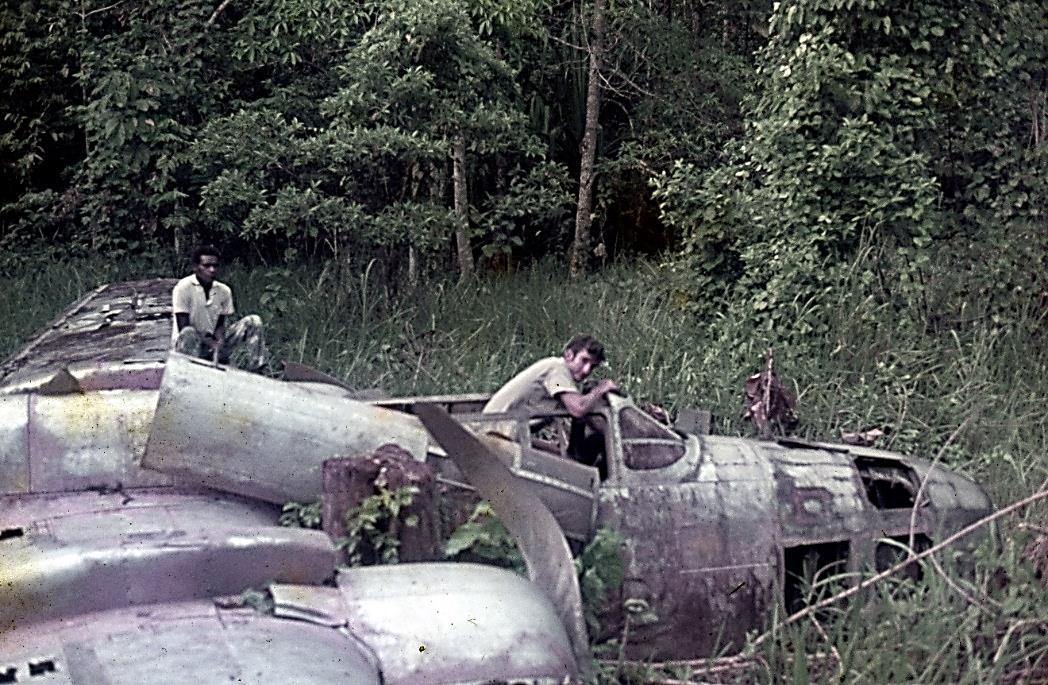

21
At Lae, a steam crane loading the Junkers G31s. An Austin 7 being loaded.
Source PNGAA. Bugger up Gogol.
Ian Whyte was as bad a pilot as his bagpipe playing with WW 2 Bomber NW Gogol in Gogol TA20 . 1972/ Photo credit Ian Whyte.
20 Bomber details p 12-13 PNGAF Mag issue # 9B-5B4W2 of 2/9/2021 Eminent TPNG Forester Ian Whyte.
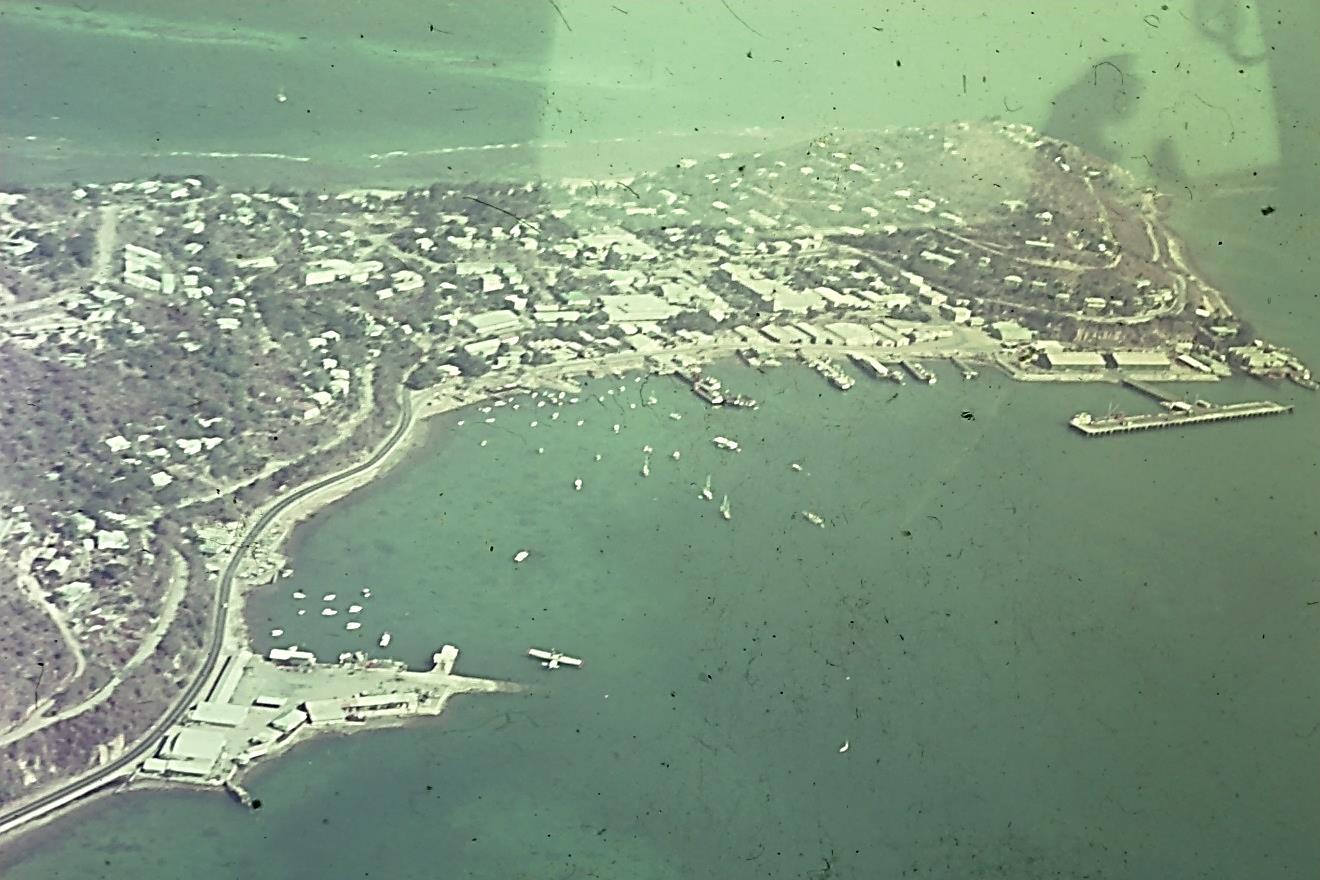
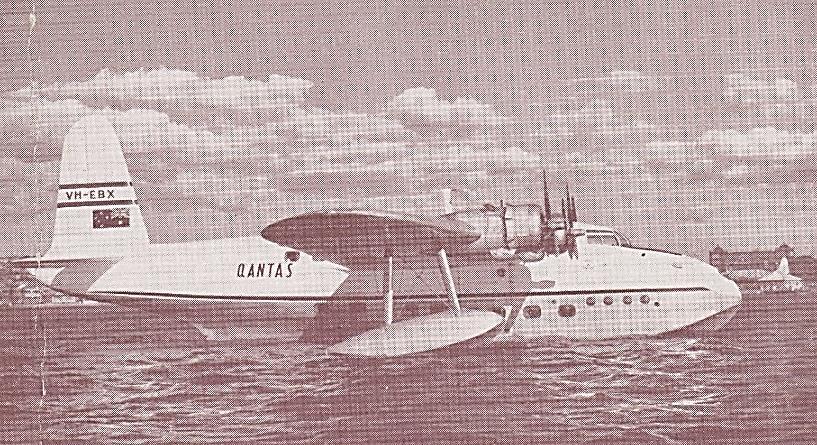
22
Paul Ryan off to school in a Qantas Sandringham flying boat from Moresby to Sydney in 1954. Photo credit Paul Ryan.
Catalina flying boat Port Moresby 1963 conveniently parked near the old Yacht club. Photo credit Ken Granger.
.
Timber baulks being flown out of Bulolo. Source Department of Territories 1959.


DC 3 Wewak. 1963.
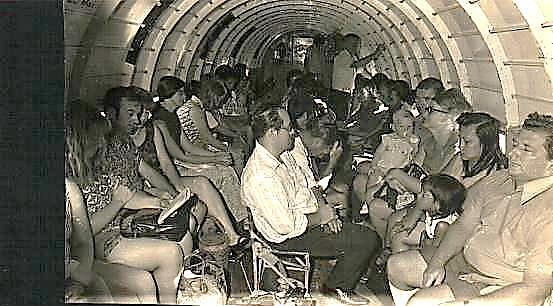
Photo credit Ian Smith DC3 Side saddle. PNGAA
DC3 TAA Domestic Service, Wau.1964.
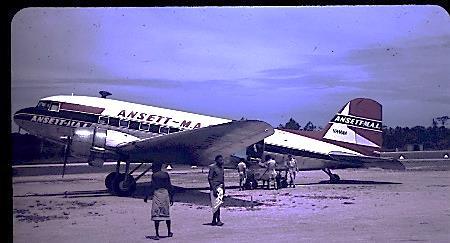
Photo credit Des Harries.
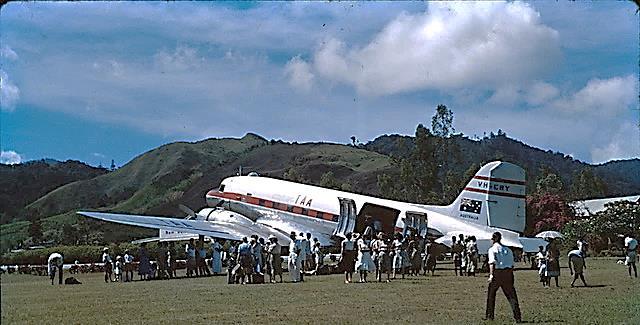
23
Joys of Flying
PNG - Tapini airstrip. Photo Credit Neville Howcroft 1972.
Strips such as Tapini were serviced by Mission Air with planes like the Mission Air Islander pictured at Ossima Airstrip used by the forest survey team in 1970.
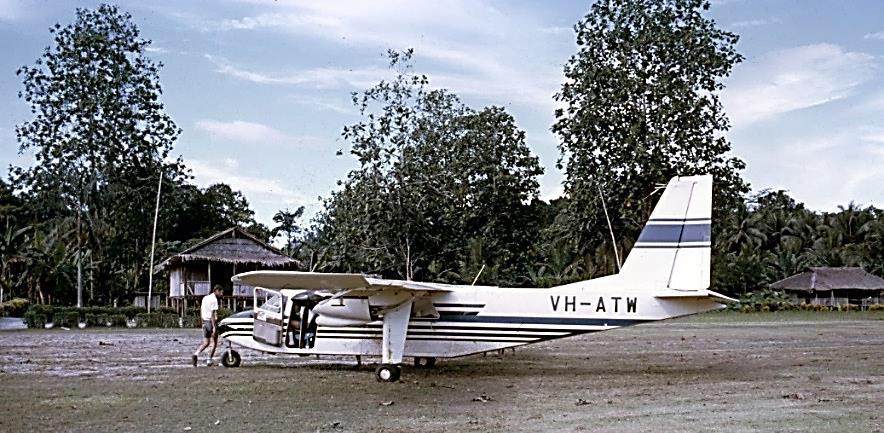
Photo credit Ian Whyte 1970.
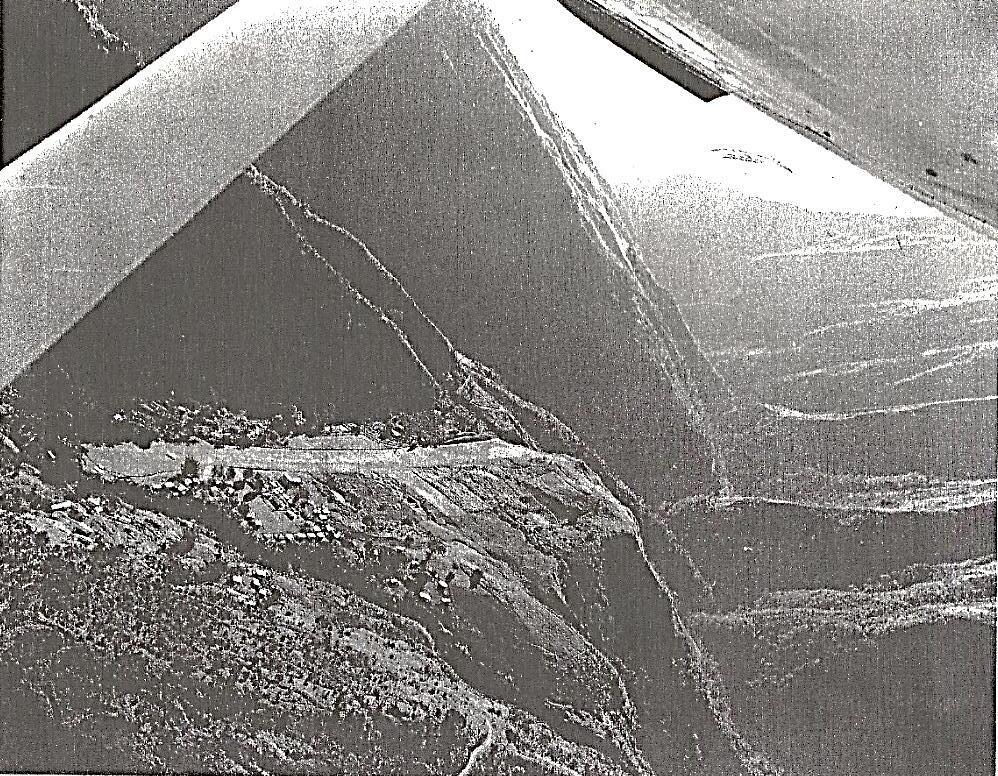
An Ansett-ANA

“Skymaster,” a four engined, propellor driven aircraft that operated the Sydney-Brisbane-Port Moresby-Lae and return route in the early 1960’s. Photo credit John Davidson.
This allowed more ticketed (ticket of leave) Queenslanders to migrate to and from PNG.
24
BY CLOUD (
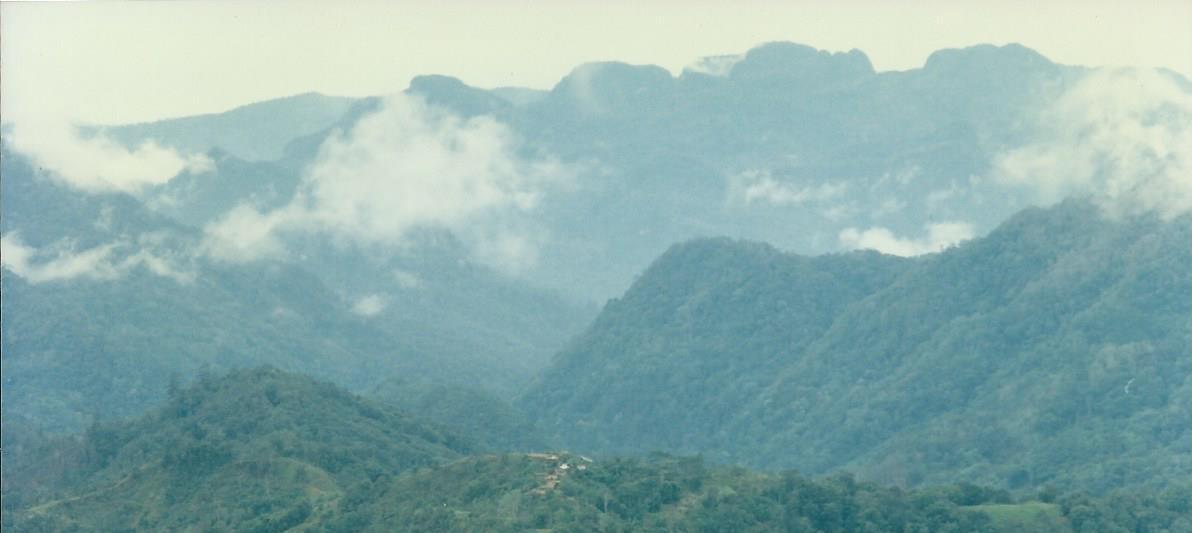

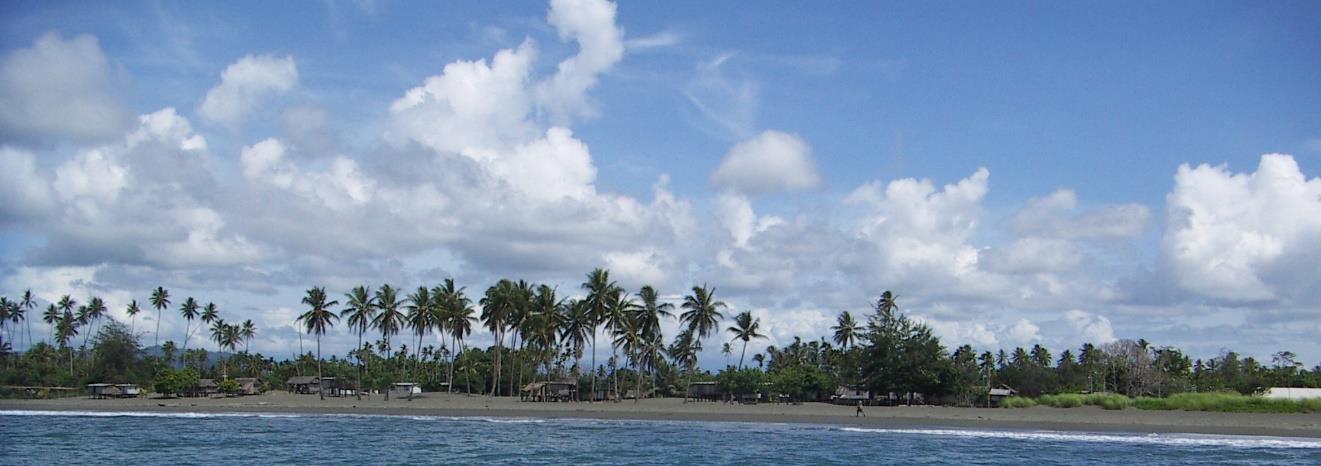
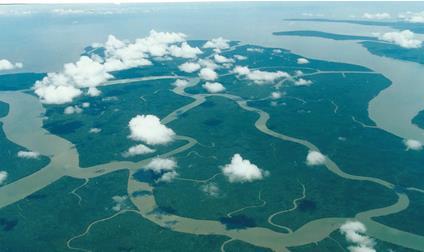
25
ahead of their time those Queenslanders)
Queensland Clouds from the coast to the Highlands. Photo credit D McCarthy.
BY ROAD VECHILE TRANSPORT- (roads basically did not exist).


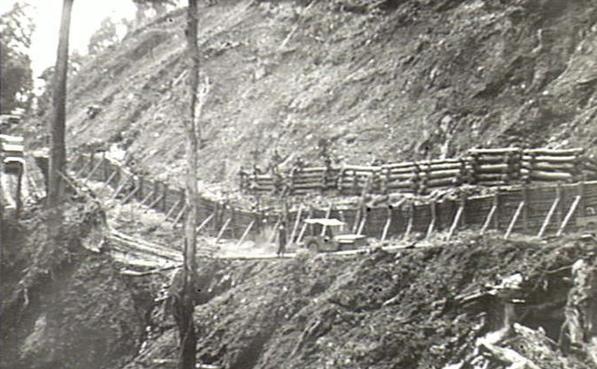
BULLDOG TRACK (also called Bulldog Road; Bulldog-Wau Road; Reinhold Highway.) Originally, the Bulldog Track was a walking track used by local people to cross the mountains. After the Australian Army built a vehicle road (1943-44) it became known as the “Reinhold Highway”, “Bulldog Road”, Bulldog Wau road.21 .
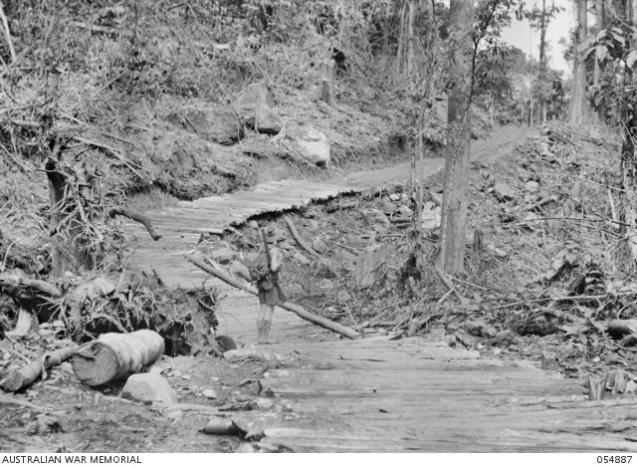
21 PNG Mag Issue # 3of 30 oct 2020 pages 18-23

26
Bulldog-Wau Road, New Guinea, 1943. Corduroyed section of road.
Timber pole work Bulldog Wau Road. Photo Credit Australian War Memorial.
John Smith bogged somewhat near Wewak. Photo credit Ian Smith (Father John Smith’s collection. 1963).


27
Crossing the Markham River. First intake of BFC students heading back to Bulolo after field trip to Lae. 1963.
Photo credit Peter Eddowes.
Advance party heading toward Toimonapu Plantation. Bougainville. 1964.
Photo credit Peter Eddowes.
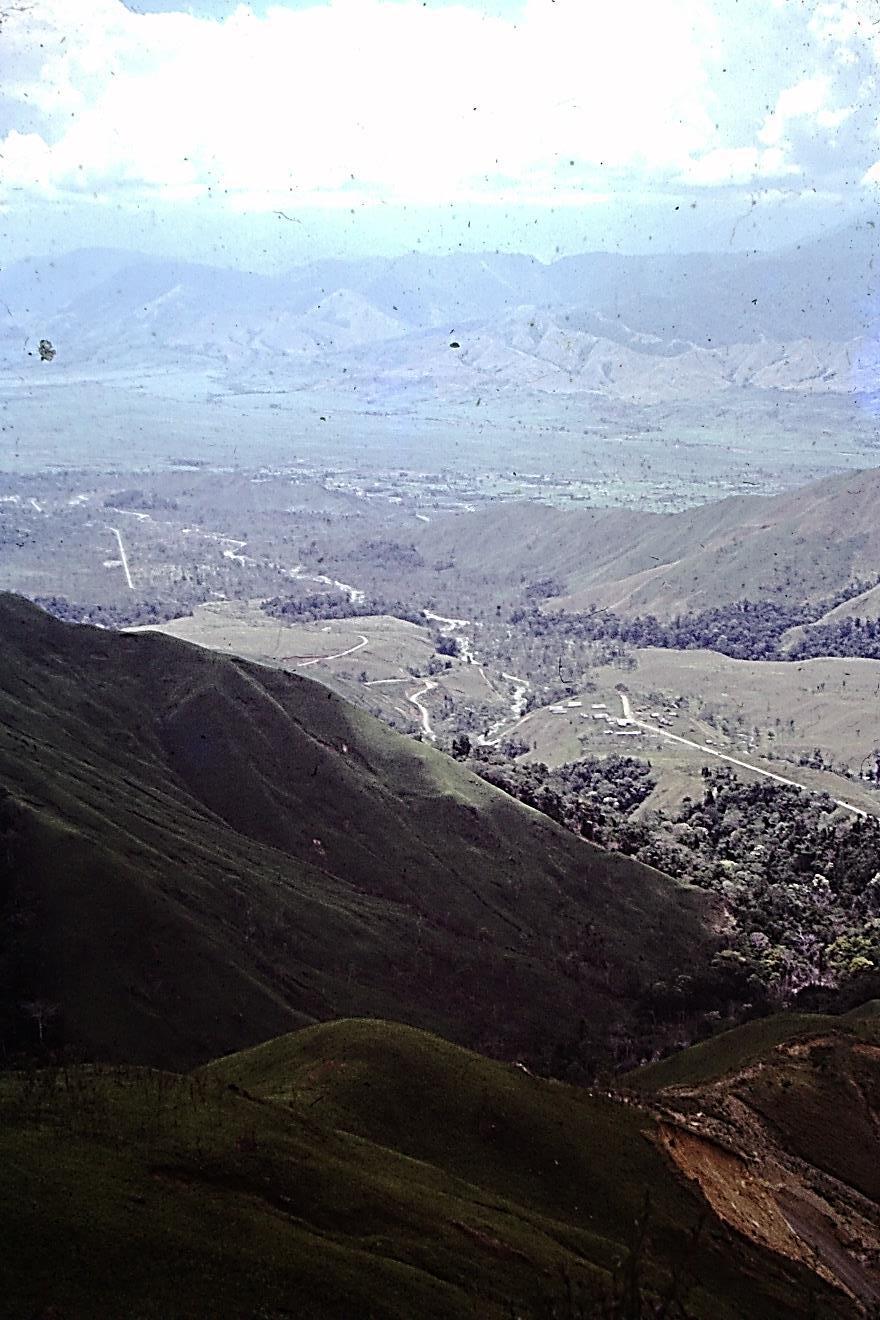
28
Kassam pass 1965. Photo credit Ian Smith from his father John Smith’s collection.
If we take this shortcut here, we should be able to get ahead.
22
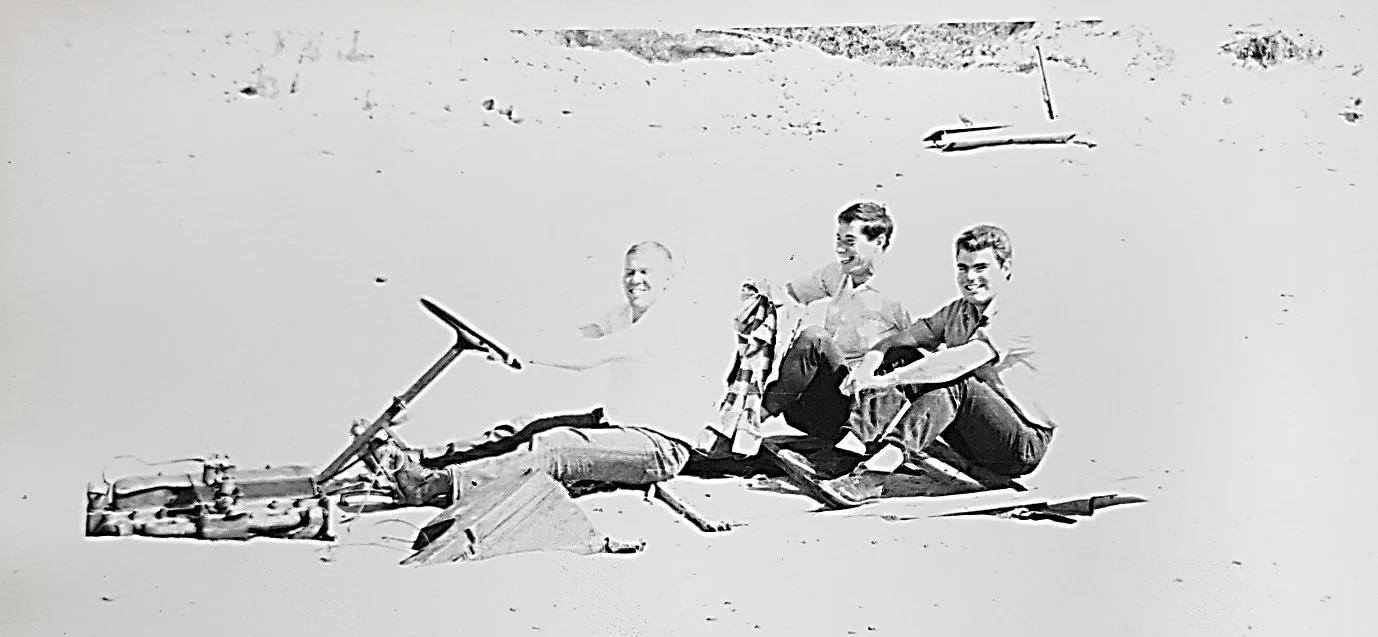
Perhaps that short cut was not a good idea after all.


29
Driver Bob Lyons TPNG forester, Dick McCarthy TPNG forester, and SA forester Alex McDonald on the sandy road to nowhere. AFS Field trip sand hills Southern Queensland 1967. Photo credit Dave Num.
Papuan Safari 1973.
Photo Credit Chris Done
22 Chris Done TPNG Forests 1966-1975
FORESTERS AS PLES QUEENSLAND







Jim McAdam33 MM. TPNG Forests 1938 - 1959
“JB” James Bannister McAdam MM TPNG 1938-1959. Photo credit Dept of Forests PNG.
Jim was a graduate of University of Queensland and AFS (dux 1932/33 awarded Schlick Medal). In 1934, he joined Queensland Forestry. In 1938 he joined the TPNG administration, Chief Forester in 1939, 1946 Director of Forests TPNG. He died in 1959

McAdam enlisted in 1940 at Wau with the New Guinea Volunteer Rifles. After the Japanese invaded Salamaua in March, he led a party of scouts which established an observation post within a mile of enemy positions. The intelligence the team gathered was crucial to the success of the Australian raid on the town in June. McAdam acted as a guide in the foray. He was awarded the Military Medal for his outstanding service at Salamaua. From 1944/45 he was Lt Col 1 Aust CRE (New Guinea Forests).
Jim McAdam’s MM influence on the practice of PNG forestry, was such that the proper scientific and utilization activities were undertaken and at the same time his protection of the traditional rights of the forest owners led to the establishment of what is today the Department of Forests of PNG, PNG’s Forest industry and its allied tertiary forestry training institutions. He took PNG forestry from a regime of tracing the early explorers of the forest resource, a small mission-based sawmilling industry supplying local needs and the export of valuable cabinet species such as walnut to what it is today.
Throughout all those turbulent times, McAdam’s leadership and foresight was demonstrated through:
• His use of the results of Army Forest Resource Survey Group to define forest types of PNG and make a reasonable estimate of large resources for future development.
• To McAdam’s credit, he insisted that all timbers harvested be recorded for eventual recompense to be made to the native owners for use of their trees. This became part of official Australian orders. Bennett34 described the compensation program undertaken by McAdam and his officers between 1947 and 1960, paying customary owners for the timbers harvested during the war.
33 PNGAF Mag Issuu #9B-5B4M3 of 12th Aug 2022 Eminent TPNG Forester Jim McAdam 1938 - 1959. First Director Dept of Forests.
34 Bennett J A Allied logging and milling in Papua New Guinea during World War 2. Fifth National Conference on Australian Forest History edited by John Dargavel, Denise Gaughwin and Brenda Libbis in 2002 ISBN 0867405309 .
41
Jim and Pat Cavanaugh’s retirement from Dept of Forests in 1972. Director Don McIntosh is standing behind Pat. Photo Credit Linda Cavanaugh Manning.

Jim Cavanaugh visited New Guinea in 1938 and joined the New Guinea Public Service in 1940. In 1941, he enlisted and served - first with the New Guinea Volunteer Riflemen (NGVR) and later with the 2nd Australian Forest Survey Company. He also conducted intelligence work with the Central Bureau He spent almost all the war years outside Australia often behind Japanese lines. He was a commissioned officer and was demobilized in December 1945. In January 1946, he returned to Papua New Guinea as a forester and was put in charge of the Northern Region He was based in Kerevat near Rabaul, and he set himself the task of getting the sawmill at Kerevat working to produce timber to rebuild the town of Rabaul after the ravages of the war. When he needed engines and gearboxes, Jim converted abandoned Japanese motors and gearboxes to power the mill He initially ran a team of Chinese labourers that had been abandoned in Rabaul by the Japanese army and later a team of Papuan New Guineans. Pat, his wife, did the books.
Jim Cavanaugh (forester), Geoff Archer (gold miner) & Jim McAdam (forester) of the NGVR taken by war photographer Damien Parer near Mubo in March 1942 before the famous Salamaua raid.

42
Jim Cavanaugh35 TPNG 1938-1972
Photo Credit Australian War Memorial 36 .
35 PNGAF Mag Issuu # 9B-5B4C1 of 20th July 2021 Eminent TPNG Forester Jim Cavanaugh. 1938-1972
36Details from Linda Cavanaugh Manning 9 April 2019
George Henry Barrcroft 1941-945
George Henry Barrcroft was born in Brisbane. He enlisted on 9 April 1941. He was a sapper in 2/3 Forestry Coy. He was discharged on 27th October 1945. After World War 2, he worked at the sawmill at Yalu via Lae.
Les Carron 1943-1945
Picture source. ANU/AFS Open Research. Les Carron (1920-2004) Queensland Forestry cadetship in 1938. At the advent of WW 2, he enlisted in the Army’s First Australian Survey Corps mapping vegetation in Queensland. In 1944 he joined a Forest Engineering Group in New Guinea undertaking aerial photo interpretation working with Dr Max Jacobs. After the war he completed forestry studies including 1946/47 at AFS. Back to Queensland in 1948 working in research and then as a sub-district forester at Beerwah. (When he was first married, they had three wooden cases, one large and two small The large one served as a table and the others as seats.) In 1949 he joined AFS where his early teaching was in mensuration and photogrammetry with contributions to surveying and statistical methods
George Carter 1944- 1945

George Carter was a Forest Overseer/ Ranger in Qld Forestry. During WW2, he served as a WO2 with the Australian Forestry survey group PNG and then returned to Qld Forestry.

Bob Cattanach 1940-1972
Robert Gordon Cattanach served in the 9th Division in the Middle East and PNG during World War 2. He enlisted on 14 June 1940 and was discharged on 4 March 1944. In PNG he was in the 2/25 Inf Battalion and discharged while his unit was still in the Finschhafen area, which implies he must have been wounded in the Lae/Finschhafen fighting. His first posting to the PNG administration was as a tractor operator at the Kerevat Government sawmill in the late 1940’s. In 1955 he was posted to Bulolo as a Senior Technical Officer where he was responsible for all the road construction and maintenance work in the extensive reforestation areas of Bulolo and Wau. He retired in 1972 to Queensland Died 1996.
Ernie Clifton 1941-1975
Ernie Clifton enlisted at Bexley in 1941. He served with 2/25 Field park Company. After the war, HQ Clerk Forests.
Anthony Lawrence Edwards – (Laurie) 1943-1970’s
Anthony Lawrence Edwards was born in Newcastle, NSW. He enlisted on 3 July 1943 at Darley and served as a sapper with HQ2 Aust Corps. After WW2, he was 2IC in TPNG Forests mapping section as a draftsman including time at BFC Bulolo teaching.
43
Ted Collis 1940-1975
L to R Dick McCarthy, Ted Collis and Kevin White Mid 1970’s Bulolo Plantations Photo credit John Davidson.
Ted Collis during World War 2, served as a corporal in the 2/1 Australian Forestry Company. In 1946, Jim McAdam approached Ted Collis to go back to New Guinea to help rebuild Lae. Ted said “no way not going back to that place” but was persuaded when he knew other army mates were going. He ended up in Yalu 20 miles out of Lae at a sawmill. The only army mates that Norma Collis recalls was George Barrcroft; Darby Munroe plus others that were living there – Alan and Ken Fraser; John Thompson; Eric Dobson; Col Pittaway and Bill Jenkins. Yalu had no houses, and these were built from scratch with the timber from the local area. 5-6 houses were built and a singles quarter. When the mill closed in Yalu in 1955, everyone moved to Lae to a new mill. In 1960, this mill closed because of competition with private business and then the sawmill became the Lae markets Ted had to choose transferring to Port Moresby or Bulolo to work for the Department of Forests. Bulolo was his choice as he was put in charge of the nursery at Bulolo He was responsible for a million and quarter klinkii and hoop pine trees to be planted out in the plantation every year. These trees were logged by the Bulolo Gold Dredging Company (BGDC). Ted in 1975 retired to Bribie Island.
1964 Photo Forestry College staff housed in temporary quarters near Bulolo Forestry Station Office. Front row L to R Hi, Norma Collis, Arthur "Blue" Ramsay, Joe Havel, Bill Finlayson and Heinar Streimann. Photo credit Norma/Cheryl Collis.
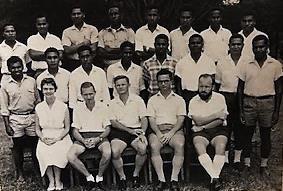
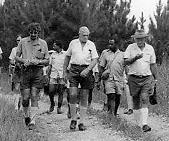
Don Fryer 1940-
1960’s
Don enlisted at Rose Park. He served with 2 Provost Company. He was a forest ranger with TPNG Forests at Kerevat. He was killed in a road accident at Kerevat. after the war. Fryer Logging Area was named after him.
Alan Gardner 1940-1945
Alan Gardner AFS1946-1947 was the first fire protection officer for Queensland forestry then District Forester Yarraman and Atherton. During WW2 he served as an RAAF navigator in Beaufort Bombers in PNG. He then returned to Qld Forestry.
44
Bert Gloynes 1941-1970’s
Bert Gloynes Forest Ranger Bulolo - Albert Edward (Bert) Gloynes was born in England in 1914. He enlisted at Toowoomba in 1941. He saw service on the Kokoda track with 2/5 Australian Independent Company.Hewas dischargedin 1945.AfterWorld War2, Kerevat Sawmill break down saw operator then transferred to Bulolo as forest ranger in charge of the large labour line for the Bulolo plantation program.

Bert Hanson 1940 -1970’s
Bert Hanson AFS1946-1947 was with Queensland Forestry and the FTB. During WW2 he served as a radar mechanic on HMAS Gascoyne in the south-west Pacific. He then returned to Qld Forestry before moving to the Commonwealth Forestry and Timber Bureau and appointed as Director General in 1975.
Frank Holland37 1940 to 1960’s
In 1942, J K McCarthy and Frank Holland (a timber getter) rescue some 200 Australian soldiers after the fall of Rabaul. Frank Holland then served with Z Force in East Timor and Borneo. After the war he returned to Rabaul, timber harvesting and road construction.
Michael Jackson.1941-1960’s
Mike was an early Forest Ranger with Jim McAdam. He was born in Cottesloe WA. He enlisted on 3 February 1941 in Brisbane. He was in the Royal Australian Air Force with rank of Flying Officer with 455 Squadron. He was awarded the Distinguished Flying Cross. He was discharged 18th February 1946. Later he rises to a senior position in the PNG Trade and Industry Department. He died 30 Jan 74 when his widow was living in Brisbane.
John Lowien 1941-1970’s Gogol Survey 1963. Photo Credit Mary Jenkin.
John Lowien Technical Officer Highlands Region was born in Pittsworth Queensland, enlisted at Paddington with 15 Infantry Battalion. He was discharged on 27 Nov 1946 which means he moved to the occupation force at Rabaul after the Japanese surrender. He then joined TPNG Forests, based in Goroka Highlands Region.
Jim Nugent 1941 to 1960’s
Jim enlisted with Army in North Sydney. He served as a private with 17 Infantry Battalion. In Oct 1942 he transferred to the RAAF as a leading aircraftman with 348 Radar Station POM. After the war Forests HQ clerk.
45
37 Page 78 PNG Mag Issue # 3 of 30 Oct 2020 Frank Holland
Adam Mulholland 1942-1945
Adam Mulholland38 (QX42383 (Q141167)) was a surveyor who was a farmer living at Gympie when he enlisted in 1 Bomb Disposal Coy in 1942, then RAE 5 Div in Feb 1943 and transferred to RAE Forestry in Mar 1944. He was one of the first officers (Captain) with 2 For Svy Coy PNG. Evacuated with malaria in October 1944 and discharged in January 1945. Presumably, a relative of Bill Mulholland, long time Senior Ranger at Yarraman who started in Forestry at Amamoor
https://www.couriermail.com.au/news/queensland/gympie/rich-history-of-widgeecrossing/news-story/1d3a5e4bd0711ead61add4b5030b52a4
Douglas Munro (Darby Munro) 1940-1960’s
Officers outside mess of 2/3
Forestry Coy. Lae NG
21/12/1944. #1 Capt. G
Brown; # 2 Lt E J Bates; #3
Lt D H Munro; # 4Capt J
Saxton; # 5Lt K L Ross; # 6
Lt C L Cameron; # 7 Major HR Parke Officer
Commanding. Photo credit Aust War Memorial. Darby enlisted at Kelvin Grove
Queensland. After WW 2, he worked at the sawmill at Yalu via Lae before moving to the Regional Office Lae.
Jack Ralston 1944-1945
Jack Ralston- AFS1946-1947 was a branch manager in Queensland Forestry. During WW2, he served as a WO2 with Australian Forestry survey group PNG and then returned to Qld Forestry.
Alex Richardson 1943 to 1960’s Compson Alexander Richardson (AFS 1941/42) enlisted on 5 Jan 1943 in Melbourne with RAN as a petty officer Mech (wireless) with HMAS Leeuwin. He was Regional Forester Rabaul in 1957. Alex Richardson was an ex-Queensland Forester who became Regional Forester Rabaul in 1950’s and then went back to Queensland Forestry.
Dick Reilly 1941s to 1960’s Dick Reilly enlisted at Matraville. He serves with 3 Forestry company in UK and NG. After the war, OIC logging crew for Kerevat Sawmill.

Reay Weidenhofer 1940-1960’s
Reay Thiselton Weidenhofer (Ray) enlisted at Wau TPNG on 19 November 1940. He was a Warrant Officer Class 2 with ANGAU. He was discharged on 3 May 1946 then Forestry Clerk for Accounts and later Executive Officer Forests Headquarters.
46
38 Personal communication Graham McKenzie Smith, Dick Pegg and Gary Bacon 18th April 2023.
Tony Robinson 1944-1945
Tony Robinson – AFS 1946-1947 was a divisional director in Qld Forestry. In WW2, he served with the Australian Forestry survey group in PNG and then returned to Qld Forestry.


AFS Cricket team Baradine
1946.
Standing L- R
Phil Barrett (lecturer)
Jack Henry
Graham Lugton
Bill Bryan
Tony Robinson
Dick McArthur
Seated L- R
David Lejeune
Tom Brabin
Jim Alexander
Alan Hatch
Source ANU/AFS Archives.
Lindsay Stuart Smith39 1940-1945
Photo source CHAH.
Lindsay Stuart Smith served as a Lieutenant in 1 Aust CRE New Guinea Forests. He is best remembered for his work on rainforest trees resulting from his early association with C T White and W D Francis and work on New Guinea plants during his army service. Some of his collections became the nucleus of the Lae Herbarium. He returned to the Queensland public service after the war.
Bill Suttie 1941–197040
Bill Suttie 1957 Bulolo Plantations. Photo credit L Cavanaugh.
Bill Suttie, (AFS 1931/32), Queensland Forestry, 3 Forestry Company in UK, OIC 1 Australian Forest Survey Coy in New Guinea After the war, Queensland Forestry District Forester Atherton resigned in 1956 to join the Department of Forests TPNG. Here, he rose to be the second Director of Forests in PNG. After retiring from TPNG he lived at Caloundra until his death in 1982.

Frank Vickery41 1942-1960’s
Frank Vickery enlisted in 1942 in Wau TPNG, rank WO2 with ANGAU. Two officers of the pre-war forestry service Jim Cavanaugh and Frank Vickery were recruited by Jim McAdam in 1944, for the CRE NG Forests unit to record the many sawmilling operations
39 L S Smith page 32 PNGAF Mag Issue # 3 of 30th Oct 2020.
40 Bill Suttie page 81 PNGAF Mag Issue #3 of 30th Oct 2020.
41 F Vickery page 83 PNGAF Mag Issue #3 of 30th Oct 2020.
47
and make surveys of the forest resources, using all the advantages of operational mapping, air photos and transport facilities then available. One of the functions of the CRE NG Forests was the maintenance of forestry records suitable for handing over to a Civilian Forest service at the appropriate time. Consequently, when the unit was disbanded, Mr. Vickery, by then the forest ranger at Bulolo, was left in charge of the records. He handed the records to Mr Cavanaugh, who was then the Reserve Settlement Officer, when he returned to the Islands in his civilian capacity. Frank was the father-inlaw of Robin Morwood who married Franks’ daughter Joan.
Cyril Tenison White42 1943-1945
Photo source Wikipedia.
Cyril Tenison White (1890-1950) was Queensland’s Government Botanist 1917 to 1950. He instructed forestry companies of the Australian Army in New Guinea in 1944


Ed Volck 1944-1945
Ed Volck – AFS 1946-47, was a branch manager with Queensland Forestry. During WW2 he served as a WO2 with the Australian Forestry survey group in PNG and then returned to Qld Forestry.
The tree species Neorites kevediana (Fishtail silky oak) (Proteaceae) was named by Queensland Government botanist Dr Lindsay Smith in 1969, based on a specimen collected near Kuranda in 1955 by Queensland forestry officers Kevin J. White and H. Edgar Volck. Smith coined the species name from the first names of the finders.
Nangwarry 1946 AFS
First Camp 1946-47. L-R

Brain Healy
Dick McArthur
Jim Alexander
Les Carron
Jack Henry
Ed Volck (obscured)
Graham Lugton
Bert Hansen
Alan Gardiner
Source ANU/Afs archives.
48
42
C T White page 33 PNGAF Mag Issue # 3 of 30th Oct 2020.
Kevin White 1942-1945 and 1957-1977

Photo credit John Davidson Kevin White43 (AFS 1950/51) succeeded Dave Dun as Chief of Silviculture from 1958 to 1977. Kevin played a pivotal role in the planning and supervision of silvicultural research in PNG. Kevin enlisted in the AIF in 1942 with 39 Light Wireless Air Warning Section, then attached to the 2nd Australian Corps Signals at the transmitter centre on the Sattelburg trail above Finschhafen, and later at Torokina on Bougainville. Discharged 1946, he re-joined the Queensland Public Service and retrained under the Commonwealth Reconstruction Training Scheme and became a Cadet Forest Officer of the Queensland Department of Forestry graduating with Dip. For. in 1951 (AFS) and B.Sc. (For.) in 1952 (Qld Uni). The next five years were spent on rainforest management research in North Queensland partly at the Forest Research Station at Atherton. Kevin transferred to the Forest Department of the Territory of Papua & New Guinea in 1957 as Assistant Botanist and Plant Ecologist at the Botany Division of the Department in Lae rising to Assistant Director Dept of Forests PNG.

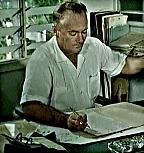
Keith Cullen44 1940–1971.
Keith Cullen (back to camera) with Kevin White Kone Club 1970. Photo credit Ken Granger.
Keith at work. Photo credit Alan Cullen.
Keith, enlisted in 1940 with the 5th Australian Field Survey Coy serving from Brisbane to the Cape, Thursday Island, Merauke, Morotai, Balikpapan, Makassar, and the Borneo Theatre. After the war in 1946, Keith Cullen was recruited from Queensland Forestry by Jim McAdam to work in Lae on aerial photography, then Konedobu as Chief Draftsman. He retired in 1971 for Queensland.
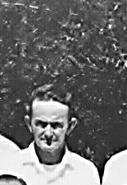
John Thompson 1940’s to 1960’s John Thompson served with occupational forces in Japan after the war. He was then in Bulolo as a forest ranger working with Leon Clifford on forest research and then field manager for the Bulolo Forestry College. 1970 Bulolo Forestry College. Photo Credit Garry Flegg.
Eric Dobson 1940’s to 1960’s Eric Dobson enlisted at Wollongong. He was a signalman with ANGAU. After the war, He worked at the TPNG sawmill at Yalu.
43 PNGAF MAG # 3 of 3 Nov 2020 page 85, PNGAF MAG # 4 of 21/11/2020 p35-37, PNGAF MAG # 6 OF 8th Jan 2021 p 45-47. PNGAF Mag Issue# 9B-5B4W3 of 13th Aug 2022 Eminent TPNG Forester Kevin White.
44 Keith Cullen page 73 PNGAF Mag Issue # 8 of 1st Feb 2021 PNG Forest Mapping
49
1946 TPNG Dept of Forests Sawmill crew Yalu after World War 2. Although unclear personnel included Ted Collis, Alan and Ken Fraser, Col Pittaway, John Thompson, Eric Dobson, Bill Jenkin, George Barrcroft, Darby Munro.
Photo credit Cheryl/Norma Collis.
Alan Fraser 1940’s to 1960’s
Alan Munro Fraser enlisted on 25 May 1940 at Maryborough and was discharged on 27 July 1945. He was a private and prisoner of war in Germany. In NG, he was in the 2/15 Infantry Battalion. After WW2 he was at Yalu sawmill, then technical officer and OIC at Kerevat plantations and then Technical Officer Bulolo plantations.
Ken Fraser 1940’s to 1960’s
Kenneth Roderick Fraser service number 422357 enlisted on 23 May 1942 in Adelaide and discharged on 5 October 1945. He was a corporal with RAAF at Air Defence HQ Port Moresby. After WW2, he was at Yalu sawmill and then as a forest ranger.
Col Pittaway 1940’s to 1960’s
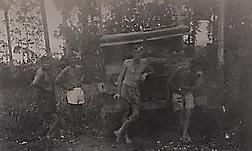
Col Pittaway was an NSW 9 Battalion VDC man discharged in December 1943 when only 18. After World War 2, he worked at the sawmill at Yalu via Lae.
Ted Gray45 1948-1969
Ted Gray (AFS 1950/51), an inaugural member of the 1948 TPNG Forest cadetship class with Alex Hart, Dr M Jacobs and Don McIntosh Source ANU/AFS Archives.
Ted’s activities included Forest officer, Regional Forester Papua, Acting Chief of Division Utilisation. In 1969 left to undertake a PhD at Berkeley California then joined the World Bank Ted’s description of work activities re forest inspections prior to the advent of helicopters vividly outlines the hazards of exploring the forests of TPNG.

50
45
PNGAF Mag Issue # 9B-5B4G3 of 25th July 2021 Eminent TPNG Forester Ted Gray 1948-1969
Ted Gray, Don McIntosh, Frank White, Papua New Guinea 1951.


Source ANU/AFS Archives.
Rex Wiggins (1958- 1975)
Rex joined Forests in 1958 as an Accounts Clerk, progressing to Regional Clerk, Accountant, Executive Officer. His postings included Port Moresby, Bulolo/Wau, Lae Regional/Sawmill/Botanic Gardens, Rabaul Regional/Keravat to Port Moresby. In 1971/72 he moved to the Finance Department and departed PNG in 1976
Ted Roach 1960’s
Ted was sawmill manager at Kerevat Sawmill till its closure around 1960 and then a major role in harvesting and marketing from Rabaul regional office.
Ken Skyring 1960’s
Ken worked on Kerevat Logging operation under Dick Reilly and then transferred to Lae Regional office.
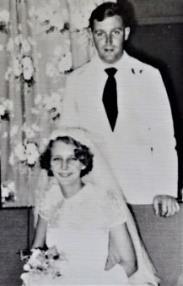
Les Austin 1960’s
Ken oversaw the Kerevat sawmill mechanical servicing workshop and then transferred to Port Moresby Forest Products Research Centre He retired to Queensland.
Ken Weir (l) and Les Austin (r) 1963. Photo credit Ken Granger.
Arthur Mobbs 1960’s
Arthur was the Kerevat sawmill saw doctor and then transferred to Port Moresby FPRC.
Robin Morwood46 1952-1962
Robin Morwood -TPNG forestry cadet (AFS 1955/56) who died in service in 1962 (age 29) in Lae. He was survived by his wife Joan (daughter of frank Vickery) and nine-month-old son Brian. A Trust Fund was established by the Morwood family in memory of their son Robin to provide a prize for the student showing the highest academic achievement in the BFC diploma course. Joan and Robin Morwood’s Wedding Wau 1960. Photo credit Norman Morwood.
51
46
14
Feb
PNGAF Mag Issue # 9B-5B4M4 of
th
2023 Eminent TPNG Forester Robin Morwood
Dave Dun47 1955-1961
Dave (AFS 1944/45) was first based at Bulolo in 1955 and then in Port Moresby as the Chief of Division of Silviculture from 1956-1958 to Deputy Director in 1961. He participated in forest plantation research. In 1957 Dave prepared a paper titled “Plantation research, Bulolo” for the pre-conference tour 7th British Empire Forestry Conference In 1961, he departed for FAO. 1957. L-R Jim McAdam, Dave Dun, Bill Suttie Bulolo. Photo credit Linda Cavanaugh.
Ian Grundy48 1954 -1966
Ian (AFS 1958/59) at their son Neale’s 2004 Wedding. Photo credit Pauline Grundy and family.
Postings included Brown River plantations to the utilization division. Returned to Australia 1966 APM Forests 1996, Savoy Corporation, APM Forests Petrie 1974, Indonesia.



Des Harries49 1955-1976

L to R Paul Ryan, Des Harries, June Harries Maleny Qld. Photo credit Des Harries. Des Harries (AFS 1958/59) joined TPNG forests in 1955. AFS His postings included Wau plantations50 , Kerevat plantations, Rabaul Regional Office, and Port Moresby Wood Products Research Centre. After PNG, Canberra with the Forestry and Timber Bureau and finally with the Bureau of Rural Resources. Retired to Maleny in 1992.


Ted Henty 1957-1984 Edward Ellis (Ted) Henty (1915-2020) joined the Dept of Forests Lae Herbarium51 in 1957. He worked throughout PNG. He left PNG in 1984 He specialized in grasses and weeds In November 1986, he moved to a property in North Queensland then Melbourne, when his health deteriorated.

47 PNGAF Mag Issue # 9B-5B4D2 of 13th Aug 2022. Eminent TPNG Forester Dave Dun 1955 - 1961.
48 PNGAF Mag Issue # 9B-5B4G4 of 2nd June 2022 Eminent TPNG Forester Ian Grundy. 1955-1966
49 PNGAF Mag Issue # 9B-5B4H3 of 24th June 2022. Eminent TPNG Forester Des Harries.
50 PNGAF Mag Issue # 9D4H of 22 Feb 2022 FORESTRY IN WAU by Des Harries
51 PNGAF Mag Issue # 6 of 8th Jan 2021 – Lae Botany p 86 Ted Henty.
52
.
Eric Hammermaster52 1957-1979
Gogol Survey. Photo credit Mary Jenkin. Eric Hammermaster (1958/59) a member of the 1955 TPNG Forest cadetship class with Ian Grundy, Des Harries and Gerry Vickers. Eric’s principal duties initially in the 1960s was the setting up and organizing the initial Bulolo/Wau Forest Working Plan. Then Eric was made the key co-ordinator of helicopter application to forest assessment in PNG. Over 3.6 million hectares using helicopter techniques were assessed in the six years 1964 to 1969 53


Then Regional Forest Officer Papua, Regional Forest Officer New Guinea Islands. On retirement, worked for FAO in Bangladesh, World Bank in Liberia, Malaysia, Solomon Islands Vanuatu, and PNG.
Alan Cameron54 1956-1970
AFS 1960 mensuration exercise with Alan Cameron (AFS 1959/60) & Les Carron.
Source. ANU-AFS Archives.
Alan initiated the forest tree genetic improvement program in PNG in the early 1960’s and was involved in selection of species/varieties/clones for cultivation in the forestry and horticultural sectors55 . Later, Alan conducted studies in the Bulolo plantations on hoop pine and klinki pine and supervised silvicultural research.

Kevin White and Alan compiled the PNG silviculture bible. 56
Alan Cameron & Ken Granger Brown River burn, 1967. Photo Credit Ken Granger.
52 PNGAF mag issue # 9B-5B4H1 of 31st July 2021 Eminent TPNG Forester Eric Hammermaster 1957-1979.
53 McIntosh DH and Hammermaster ET 1968 Forest Resource Assessment using Helicopter Transport 9th Commonwealth Forestry Conference 1968.
54 PNGAF Mag Issue # 9B-5B4C2 of 16th Aug 2022. Eminent TPNG Forester Alan Cameron 1956-1970
55 Genetic improvement of teak in New Guinea. Australian Forester, 30: 76-87 (1966), and “Forest tree improvement in New Guinea. 1 Teak.” Paper prepared for 9th Commonwealth Forestry Conference, New Delhi 1968).



56 Silvicultural techniques in Papua New Guinea forest plantations, Bulletin No. 1, Division of Silviculture, Department of Forests, Port Moresby, 2nd Printing, Pp. 1-99 (1966).

53
Alan left the Territory in early 1970 and was involved in the early development of the woodchip industry in Australia and development and management of several forest harvesting and processing operations in Australia, PNG, and Indonesia. He has been a consultant to FAO, UNIDO, UNHCR, IFAD, Asian Development Bank, World Bank, AusAid, in the fields of forestry, forest industry, agro-forestry, plus several private companies in forest industry, forest product marketing and horticultural project design and property assessment, plus some training of government and private company staff in developing countries.
Alan Ross57 1950’s to 2002


Alan Ross and Kanawi Pouru MD NFS Brisbane, July 2013 having tea at his favourite Japanese Restaurant after signing the Scholarship Trust Deeds. Photo credit Kanawi Pouru.

Alan was a forester working throughout PNG to becoming the National Forest Board Secretary. On the eve of Alan’s departure in 2002, he announced and pledged to establish a Forestry Education Trust Fund. The Fund would assist with some of the living expenses of PNG Foresters selected to undergo postgraduate studies in Australian Universities. It will come into operation after the passing of both Alan and Helen.
Cliff Southwell 1957-1972
Cliff was a senior technical officer with TPNG Forests at Bulolo, Kerevat, Brown River, Wewak, Papuan Region, then private enterprise Madang. He returned to Queensland in 1976 undertaking forest industry activities.
Cliff Southwell Kerevat Planation Establishment. Photo credit Cliff Southwell

Evan Shield58 1958–1971. (AFS 1961/62) Gogol Survey 1963. Photo credit Mary Jenkin.
Evan (AFS 1961/62), on graduation 1962 Forest Management Divison, 1965 postgraduate Diploma of Forestry at the Commonwealth Forestry Institute, University of Oxford re tropical forest inventory in

54
57 Aug 2021Eminent TPNG Forester Alan Ross. 58 PNGAF Mag Issue # 9B-5B4S1 of 25th Aug 2021 Eminent TPNG Forester Evan Shield
John Colwell Chairman 21st AUSTIS March 1971 Conference Port Moresby. Source Post Courier.

Greg McDonald 1960’s Forest Products Research group wood properties then Queensland forestry.



Greg McDonald observing preparations for a ‘mumu.’ Lufa. Southern Highlands. 1965 Photo credit Peter Eddowes.

59 PNGAF Mag Issue # 9B-5B4B2 of 19th Aug 2021 Eminent TPNG Forester Neil Brightwell 1960-1984
60 Wallace W G 1966 Cutting Pads in the Forest for Bell 47G-3B-1 Helicopter Operations. Government Printer Port Moresby 1966 PNGAF Mag issue # 9B-5B2 of 30/6/21 p 16.
61 PNGAF Mag Issue # 8 of 1st Feb 2021 PNG Forest mapping p 67 Phil Ainsworth.

55
Paul Ryan62 1962-1972








Paul (AFS 1964/65) Forest Survey group to OIC Madang to World Bank forestry specialist.

Paul Ryan Jimi Valley 1968
Photo credit Paul Ryan.
Arthur Blue Ramsay 1960’s to 1970’s Blue was a Senior technical officer TPNG Forests, Forest Survey lecturer to Timber Rights Purchases officer HQ Port Moresby. He retired to Queensland.

1964 Photo Forestry College staff Bulolo.63
Photo credit Gabbie Eddowes. Peter was a Forest Ranger (1961-1963) to Wood Technologist & OIC Timber Utilization & Marketing. FPRC. He worked all over PNG and in all Provinces incl., the islands of the Bismarck Archipelago, Bougainville, Louisiade Archipelago & the D’Entrecasteaux group, Milne Bay, Central, Gulf & Western Provinces, Highlands, Lae, Bulolo/Wau, Madang, Wewak & Vanimo. This was in relation to wood & botanical expeditions & collection programs for large wood specimens (flitches) to go to CSIRO Melbourne for determination of the wood properties (physical & mechanical). From 1981 private consulting practice and timber importation in PNG woods.


62 PNGAF Mag Issuu # 9B-5B4R1 of 26th Aug 2021 Eminent TPNG Forester Paul Ryan 1962-1972.
63 Ramsay A Forest Surveying Volume 2 Papua and New Guinea Forestry School Dept of Forests 1966.
64 PNGAF Mag Issue #9B-5B4E2 of 22nd Nov 2022 Eminent TPNG Forester/Wood Technologist Peter Eddowes .

56
Peter Eddowes64 1961- 1981
Ken Granger65 1963-1970
The MONEY IN THE SWAMP photo, September 1964.
Source. Post Courier Friday 1st August 1969
Ken joined Forestry in 1963, posted to Kerevat and engaged in resource assessment in Manus; New Ireland; New Britain and Bougainville. Later, posted to Port Moresby and continued resource assessment work in New Britain, Madang, Morobe and Northern Provinces and then Management Clerk position until he resigned in 1970. After leaving PNG employed in Joint Intelligence Organisation of Defence in Canberra, JIO Representative Australian High Commission in Port Moresby, Queensland Department of Emergency Services, Australian Geological Survey Organization, and consultant in disaster risk management.

Fred Kleckham66 1965 to 1968
Fred employed in Mapping/Drafting Section Dept of Forests.
Jack Hadden 1960’s to 1970’s
Jack Haddin during the war operated bulldozers building airstrips. He commenced work with the Department of Forests in Lae in the early 1960’s. He was then sent to Forestry Bulolo as a bulldozer operator where he became Officer in Charge of Roads and Bridges. He retired to Queensland in 1975.
Neville Howcroft67 OBE 1965-2017
68 Neville Howcroft at presentation of final Balsa Project ITTO meeting Japan with Dick McCarthy PNGFIA & Diki Kari NFS. Photo credit N Howcroft.
Neville Howcroft69 OBE joined the Dept of Forests in 1965. He worked throughout PNG as a Senior Technical Research Officer, Forest Consultant and University Lecturer from Bulolo/Wau/UNITECH Lae; EHP; WHP; Enga; NGI; Central; Western Province. Lae FRI; Sepik; Irian Jaya; Milne Bay to New Britain, Rabaul Vudal UNRE. Neville departed PNG in 2017 for Queensland.

Alick Dockrill70 1966-1972
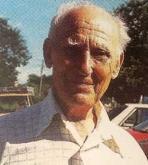
Alick was Keeper of the Herbarium Lae then moved to CSIRO Atherton.
65 PNGAF Mag Issuu # 9B-5B4G1 of 20th July 2021 Eminent TPNG Forester Ken Granger 1963 -1970
66 PNGAF Mag Issue # 8 of 1st Feb 2021 PNG Forest mapping p 100 Fred Kleckham.
67 PNGAF MAG Issue #9B-5B4H9 OF 30TH Nov 2022. Eminent TPNG Forester Neville Howcroft OBE
68 REF PNGAF MAG ISSUE # 9B4B1 of 31 May 2022.


69 PNGAF Mag Issue # 6 of 8th Jan 2021 – Lae Botany p 89 N Howcroft.
70 PNGAF Mag Issue # 6 of 8th Jan 2021 – Lae Botany p 59 Alick Dockrill.
57
Dr Barry Gray71 1966-1974
72“ STILL LOST” Photo R-L Dr Gary Bacon and Dr Barry Gray. Forest Entomologist Bulolo Forest Research. After PNG, College of Forest Resources, University of Washington. Visiting Professor Oregon State University, then life in Queensland.

Dr Ross Wylie73 1967-1974. Ross Wylie Bulolo 1968. Photo credit Barry Gray. Ross was an entomologist who commenced his career in 1967 with the PNG Department of Forests studying insect pests of trees and timber. From 1974-2006 he worked with Queensland Forestry, mainly researching pests of plantation trees and production native forests, forest health surveillance, native tree dieback and forestry quarantine. He has led research projects and conducted consultancies for agencies such as ACIAR, AusAID, FAO and Asian Development Bank in 18 countries in Asia and the Pacific. Since leaving forestry he has been Science Manager and now Science Leader in Biosecurity Queensland working on invasive ants, particularly red imported fire ant.

Mike Jones74 1967-1973.
Buso River Mouth Sept 1968 Mike Jones with BFC students. Photo credit Mike Jones. Mike joined Forests in 1967 as a draftsman/forest air photo interpreter and worked on several forestry projects including Hoskins/Kimbe NB, Gogol Valley Madang, Vanimo Puol River area West Sepik, Ok Tedi area of the Fly, Open Bay East New Britain, and Bulolo plantations. After departing PNG in 1973, Mike completed a diploma in Engineering and completed 40 years with local authorities working in civil design and construction.

71 PNGAF Mag Issue # 9B-5B4G5 of 20th Aug 2022. Eminent TPNG Forest Entomologist Dr Barry Gray.



72 Source. Post Courier Friday 1st August 1969.

73 PNGAF Mag Issue #9B-5B4W5 of 20th Aug 2022. Eminent TPNG Forest Entomologist Dr Ross Wylie
74 PNGAF Mag Issue # 8 of 1st Feb 2021 PNG Forest mapping p 96 Mike Jones.

58
Brendon Bailey75 1968-1974
Brendan’s Graduation Canberra. Photo credit Dick McCarthy.

From PNG Customs in 1968, to TPNG forests in 1969 as Regional Clerk Rabaul Forests to 1974 as Assistant Director Administration for the Department in Port Moresby. After leaving PNG, he re-joined the Australian Public Service. He completed degrees in Arts and Law and remained in public service employment until his retirement in 2007. Brendan76 worked in various public service positions, including Hansard, the Aboriginal Development Corporation, the Department responsible for Small Business, the Research section of the Parliamentary Library, and the Australian Competition and Consumer Commission (ACCC)

Jim Belford77 1970-1981. Member of the PNG Forestry Trade Training Board 1997 UNITECH Lae. Jim Belford78 Executive Officer PNGFIA. Photo Credit March 1997 National Forests and Timber Newspaper.

Jim (AFS 1966/67) joined TPNG Forests in 1970 as part of HQ Survey group, then regional forest management officer to regional forest office Lae region, Principal management officer HQ In 1981 he joined PNGFP as Resource Operations Manager and PNGFIA Secretary. He has remained in private enterprise activity in PNG including policy development and industry advocate/ representative duties, and input/industry representation to National Forest Board level 1987-1997. (E.g., restructuring the FIA to assimilate into the requirements of the Forest Act 1992.) He relocated to Brisbane but continues to have a family/business activity base in PNG and commutes when necessary
Gerd Strehler 79Cartographic Draftsman Department of Forests Drawing Office April 1972. Photo Credit Phil Ainsworth.
Gerard (Gerd) Strehler was recruited by Phil Ainsworth 80to draw topographical maps from the drawing office’s stereo plotting machines, initially a US machine and later Wild B2s stereo plotters. During WW2 Gerd was a German artillery soldier who served on the Russian front but was fortunate to be transferred to the Italian front and survive the war. After WW2 Gerd resumed his cartographic career with the US military. Gerd was also instrumental in the formation of the German Club in Moresby.
75 PNGAF Mag Issuu # PNGAF MAGAZINE ISSUE # 9B-5B4B6 of 8th March 2023 Eminent TPNG Forestry Administrator Brendan Bailey, TPNG Forests 1969 - 1974.
76 Personal Communication Phil Bailey 5th March 2023.
77 PNGAF Mag Issuu # 9B-5B4B1 of 12th July 2021 Eminent TPNG Forester Jim Belford. 1970-1981
78 Jim Belford TPNG Forests 1970-1981.
79 PNGAF Mag Issue # 8 of 1st Feb 2021 PNG Forest mapping p 108 Gerd Stehler.
80 Phil Ainsworth personal communication 1st June 2020
59
Brenton Charles Peters81 1969-1970. Forest Entomologist Bulolo Forest Research.
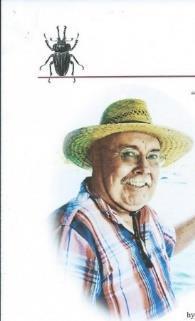
Peter Shanahan 1972-1974 Bulolo Forest Research Zoologist.


Dr Dave Lamb83 1972-1977 Bulolo Forest Research
Dave Lamb (AFS 1962/63) at an APFNet workshop. Dave Lamb’s role was to undertake research on nutrition for forest plantation development throughout PNG. He worked with Dr John Davidson and Ian Whyte on land use studies for new forest plantation developments in forest concessions such as the Gogol, Madang, and Open Bay Timber Area in New Britain. In 1977 he joined the University of Queensland and taught forest ecology.

Dr Robert ‘Bob’ Thistlethwaite84 1971-1995







Bob (AFS 1962/63) in 1971 appointed Principal Research Officer with the Papua New Guinea Department of Forests and oversaw forest plantation research, with a wide range of tropical and exotic species. In early 1978 Principal Research Officer with the Department of the Interior in Darwin and OIC of the Berrimah Research Laboratory. In 1986 Bob joined AIDAB’s (now AusAID) Pacific Regional Team as its Natural Resources Advisor. In 1989 Bob established his own natural resources and environmental consulting company. In the mid-1990’s and into the 2000s Bob continued to work in Australia as a consultant for companies he established to focus on genomic research for tree improvement.

60
Peter Shanahan82 with Ross Wylie Wau, 1968. Photo credit Ross Lockyer.
81 PNGAF Mag Issue # 9B-5B4P2 of 21st Aug 2022. Eminent TPNG Forest Entomologist Brenton Peters
PNGAF Mag Issue # 9B-5B4S3 of 22nd Aug 2022 Eminent TPNG Forest Zoologist Peter Shanahan.
PNGAF Mag Issue # 9B-5B4L4 of 20th Aug 2022 Eminent TPNG Forester Dr Dave Lamb
PNGAF Mag Issue 3 9D-5B4T2 of 20th Aug 2022 Eminent TPNG Forester Dr Bob Thistlethwaite.
82
83
84
ACRONYMS
ACT Australian Capital Territory
ACIAR Australian Centre for International Agricultural Research
ACLMP AusAid funded World Bank Land Mobilisation program.
AEC Administrators Executive Committee
AFS Australian Forestry School
AFPNG Association of Foresters of PNG
AIF Australian Infantry Forces
AMF Australian Military Forces
ANBG Australian National Botanical Gardens
ANGAU Australian New Guinea Administrative Unit
ANU Australian National University
APMF Australian Paper Manufacturers Forestry Pty Ltd
APPM Australia Paper and Pulp Manufacturers
ASIO Australian Security Intelligence Organisation
ASOPA Australian School of Pacific Administration
AusAID Australian Aid Agency
BA basal area
BCOF British Commonwealth Occupational Force 1945-52
“Beer Time” Any time.
BFC Bulolo Forestry College
BGD Bulolo Gold Dredging Company
BUC Bulolo University College
C Commonwealth cm Centimetre
CALM Western Australian Department of Conservation and Land Management
CFA Commonwealth Forestry Association
CNGT Commonwealth New Guinea Timbers Bulolo
CRE Commander Royal Engineers
CRE CRE is a term inherited by RAE from RE and is the term for the Commanding Officer of a RAE unit which is headed by a Lt Col. Although the officer is called the CRE the name is also used for the name of his unit.
E.g., CRE Aust Forestry Group or 1(NG Forests).
CSIRO Commonwealth Scientific & Industrial Research Organisation
CHAH Council of Heads of Australasian Herbaria
DASF Dept of Agriculture, Stock and Fisheries
DBH/ dbh Diameter at breast height
DEPT Department
DPI Department of Primary Industry
DOF Department of Forests
e.g. For example
Etc et cetera (more of the same)
FAO Food and Agriculture Organisation
61
F &TB Forest and Timber Bureau Canberra
FIM Forest Information System
FPRC Forest Products Research Centre Hohola
FRG Forest Red Gum
FRI Forest Research Institute Lae
Forkol Bulolo Forestry College
GAB Girth above buttress
Gbhob Girth breast height over bark
Gubab Girth under bark above buttress
GIS Geographic Information Systems
ha Hectare
HQ Head Quarters
IBRD International Bank for Reconstruction and Development
IFA Institute of Foresters of Australia
IFY International Year of the Forest
ITTO International Tropical Timber Organization
JICA Japanese International Cooperation Agency
L of N League of Nations
LRRS Land Resource Soils Survey (branch of CSIRO)
m3 cubic metre
MM Military Medal
NAA National Archives Australia
NARI National Agriculture Research Institute
NB New Britain
NFCAP PNG National Forestry and Conservation Action Plan
no. Number
NG New Guinea
NGF New Guinea Forces (relates to plant collection of Lae Herbarium)
NGIB New Guinea Infantry Battalion
NGO Non-Government Organisation
NGVR New Guinea Volunteer Rifles
NZ New Zealand
NSW New South Wales
NTSC National Tree Seed Centre PNG Bulolo
OIC Officer in Charge
P or p page
PIB
Papuan Infantry Battalion
PIR Pacific Islands Regiment
PNG Papua New Guinea
PNGAA Papua New Guinea Australia Association
PNGAF Papua New Guinea Australian Foresters Magazine Series
PNGFA Papua New Guinea Forest Authority
PNGFIA PNG Forest Industries Association
PNGRIS Papua New Guinea Resource Information System
PNGUT PNG University of Technology
62
POM Port Moresby
Q Queensland
QF Queensland Forestry
RAE Royal Australian Engineers/Australian Army
RPC Royal Papuan Constabulary
RRA Rapid Resource Appraisal
SFM Sustainable Forest Management
SP South Pacific
UK United Kingdom
UN United Nations
Unasylva Journal of FAO of UN
UNE University of New England Armidale NSW
UNEP United Nations Environment Program
UNI University
UNITECH University of Technology Lae PNG
UNRE University of Natural Resources and Environment
UPNG University of Papua New Guinea
UQ University of Queensland
US United States
USA United States of America
TPNG Territory of Papua and New Guinea
TUBL Territory United Brewery Ltd
TA Timber Area
TA Timber Authority
TRP Timber Rights Purchase
Vol volume
VSF Victorian School of Forestry
WA Western Australia
WB World Bank
63



































































